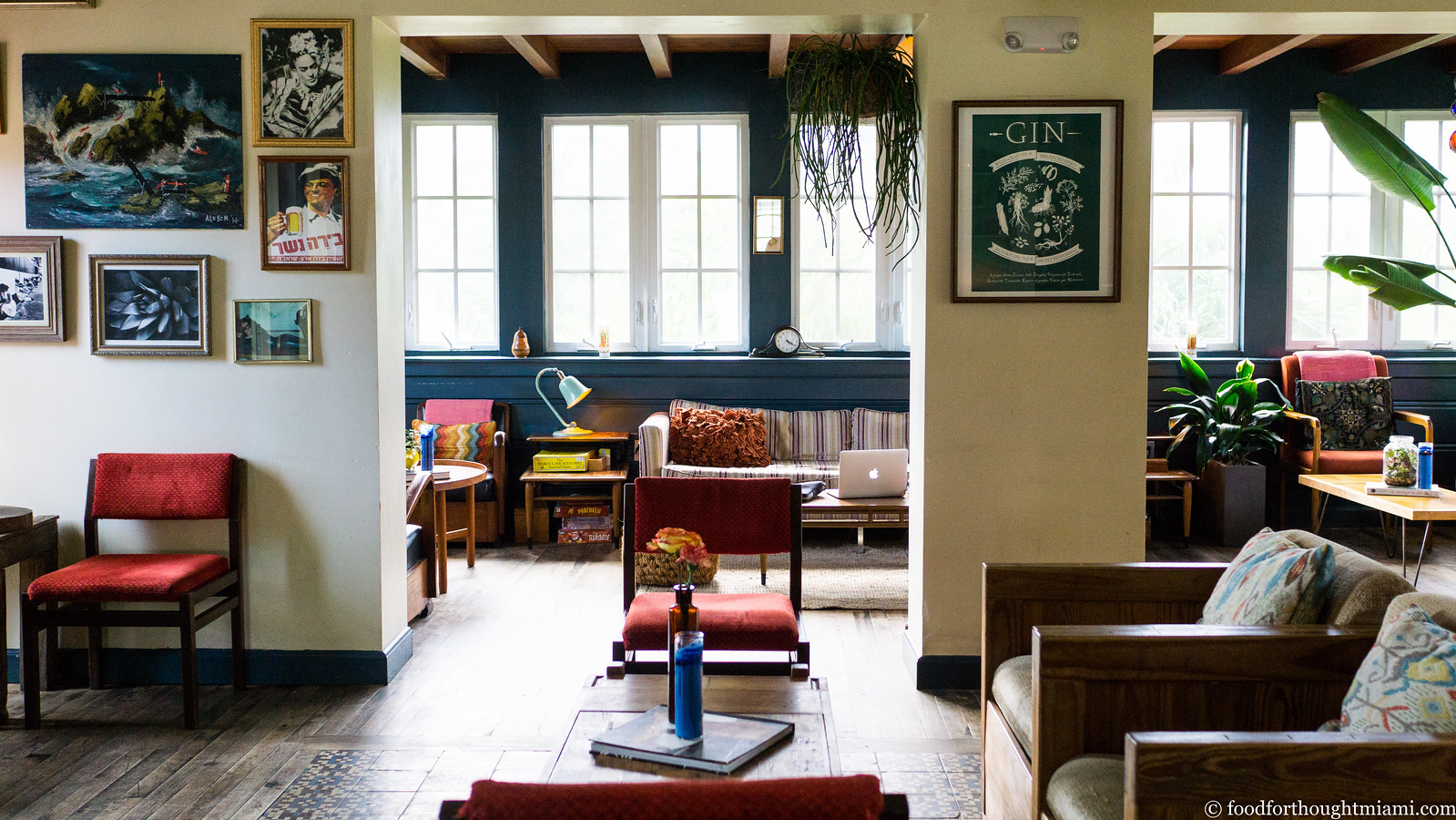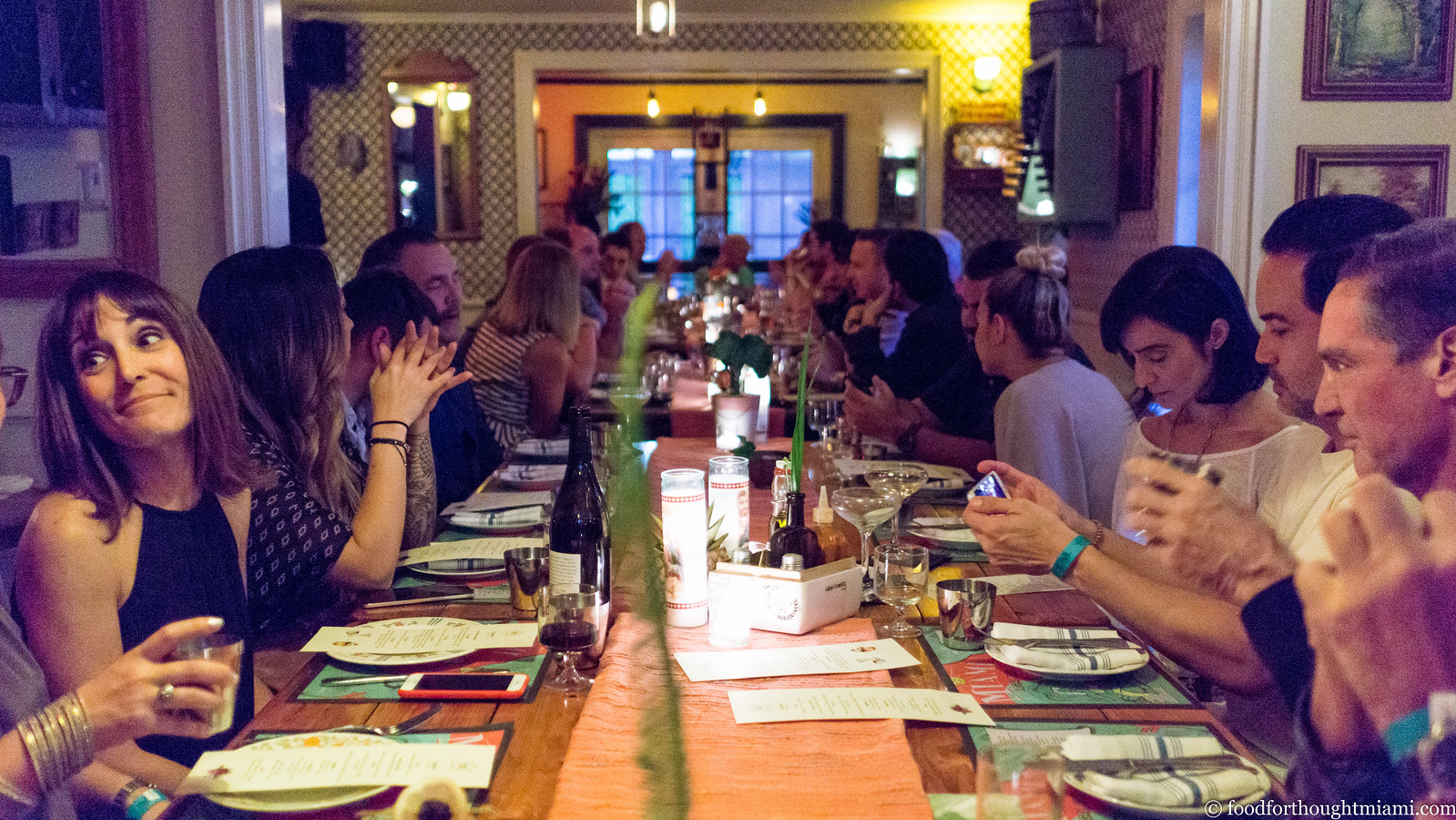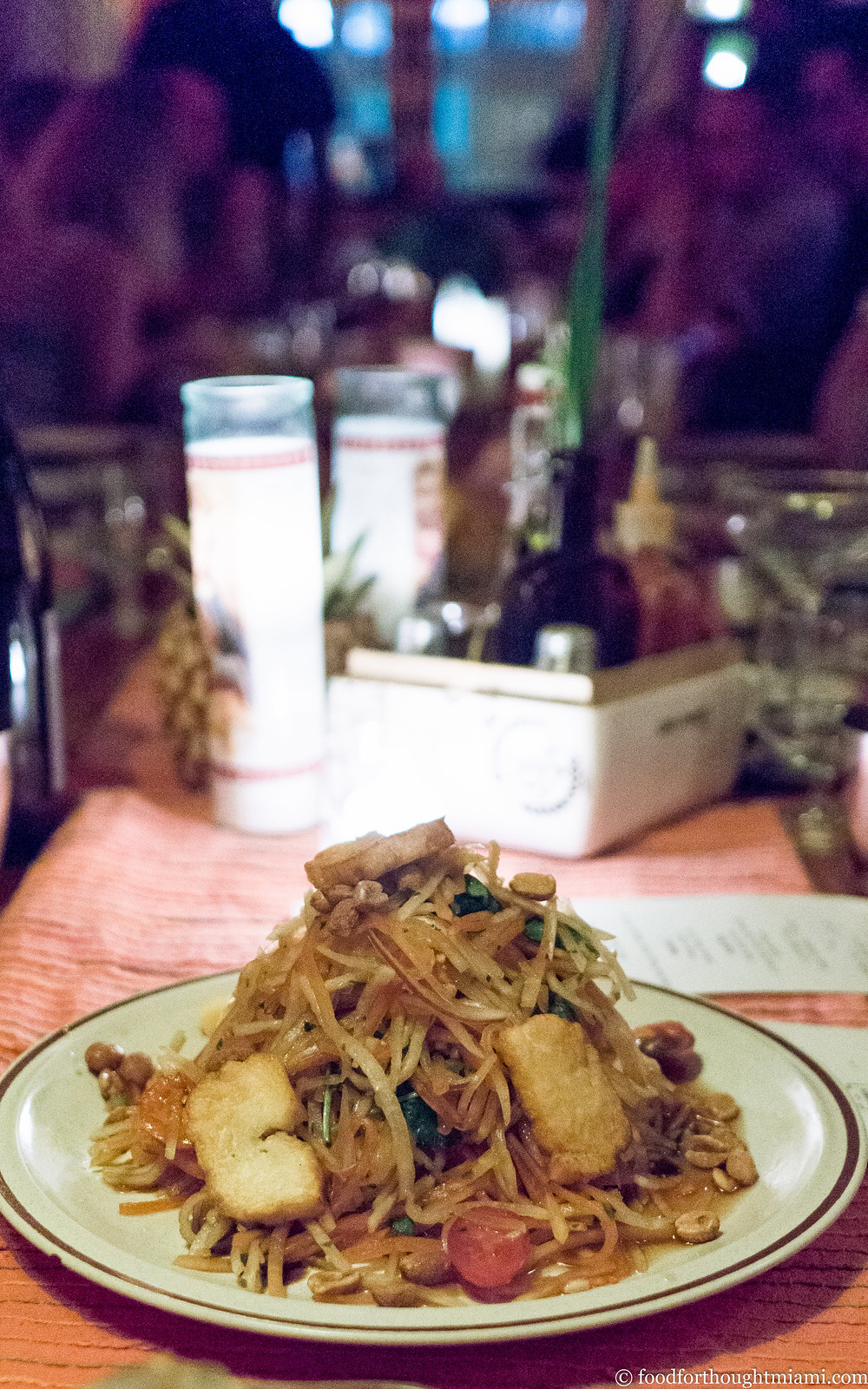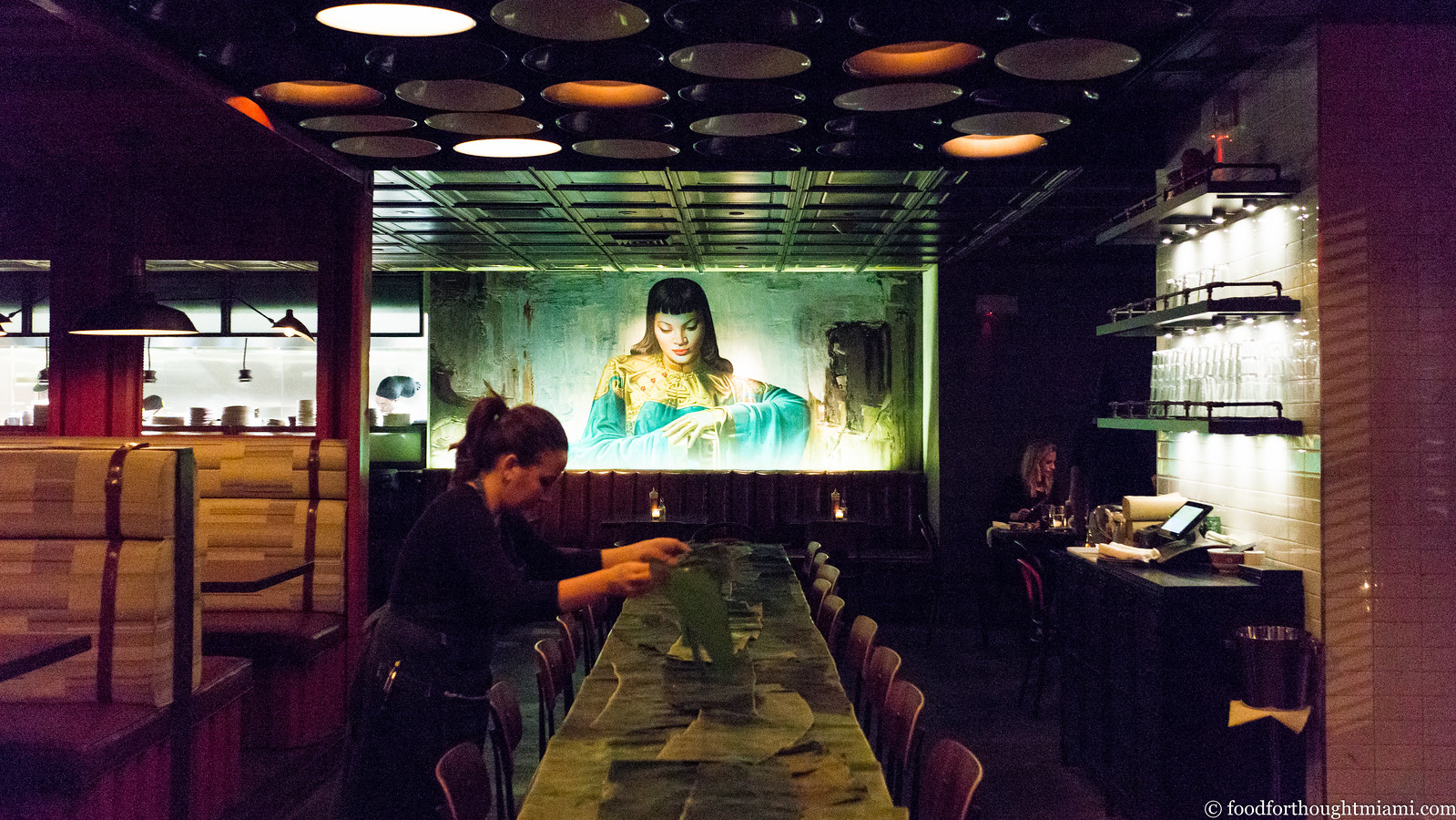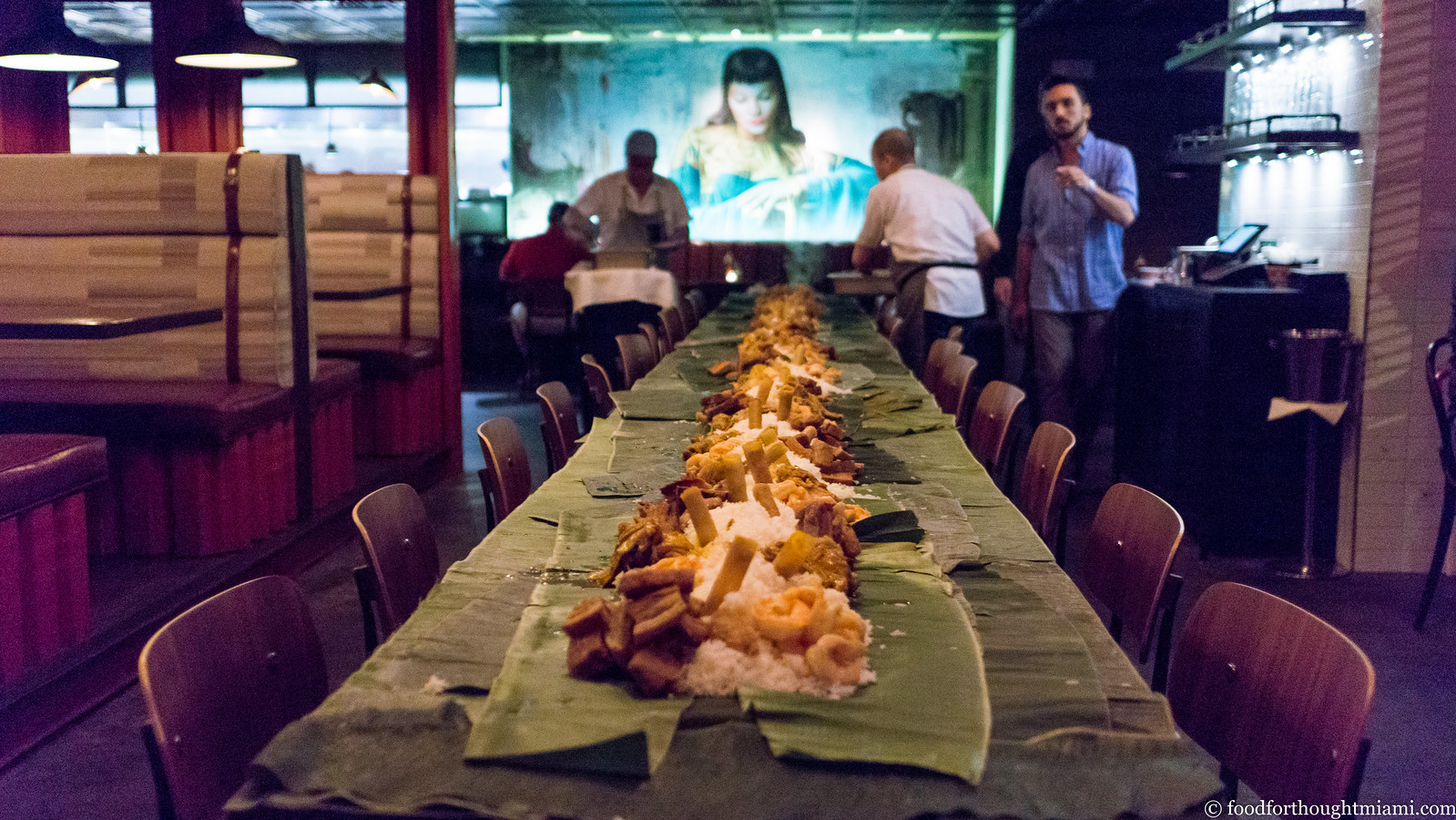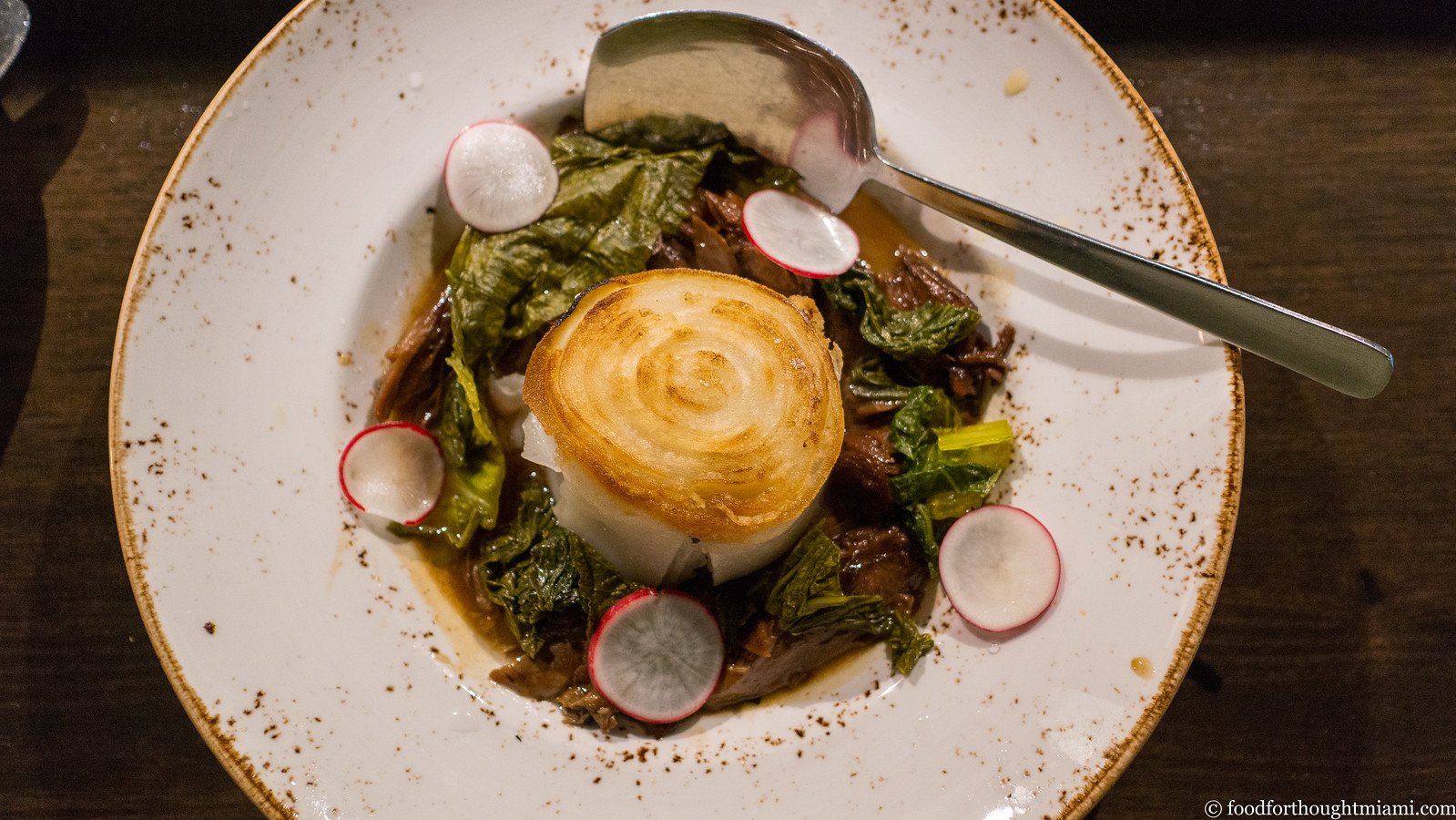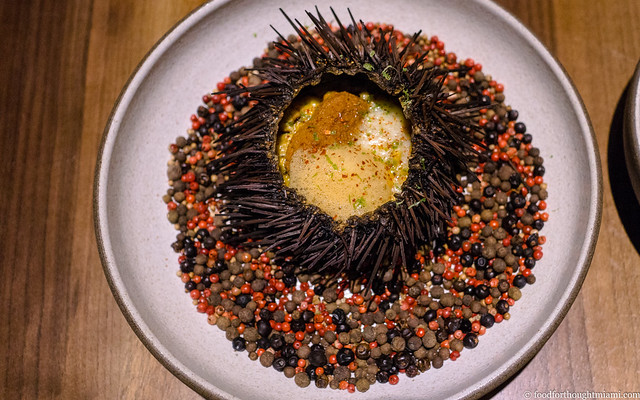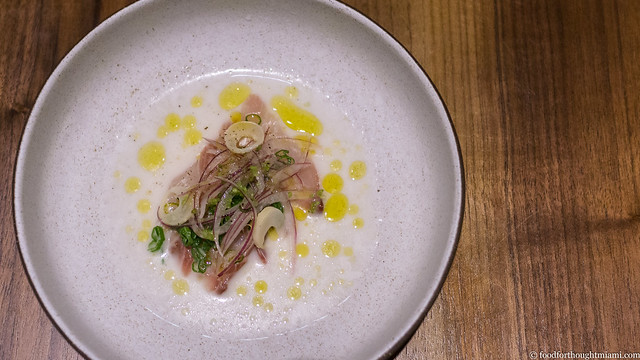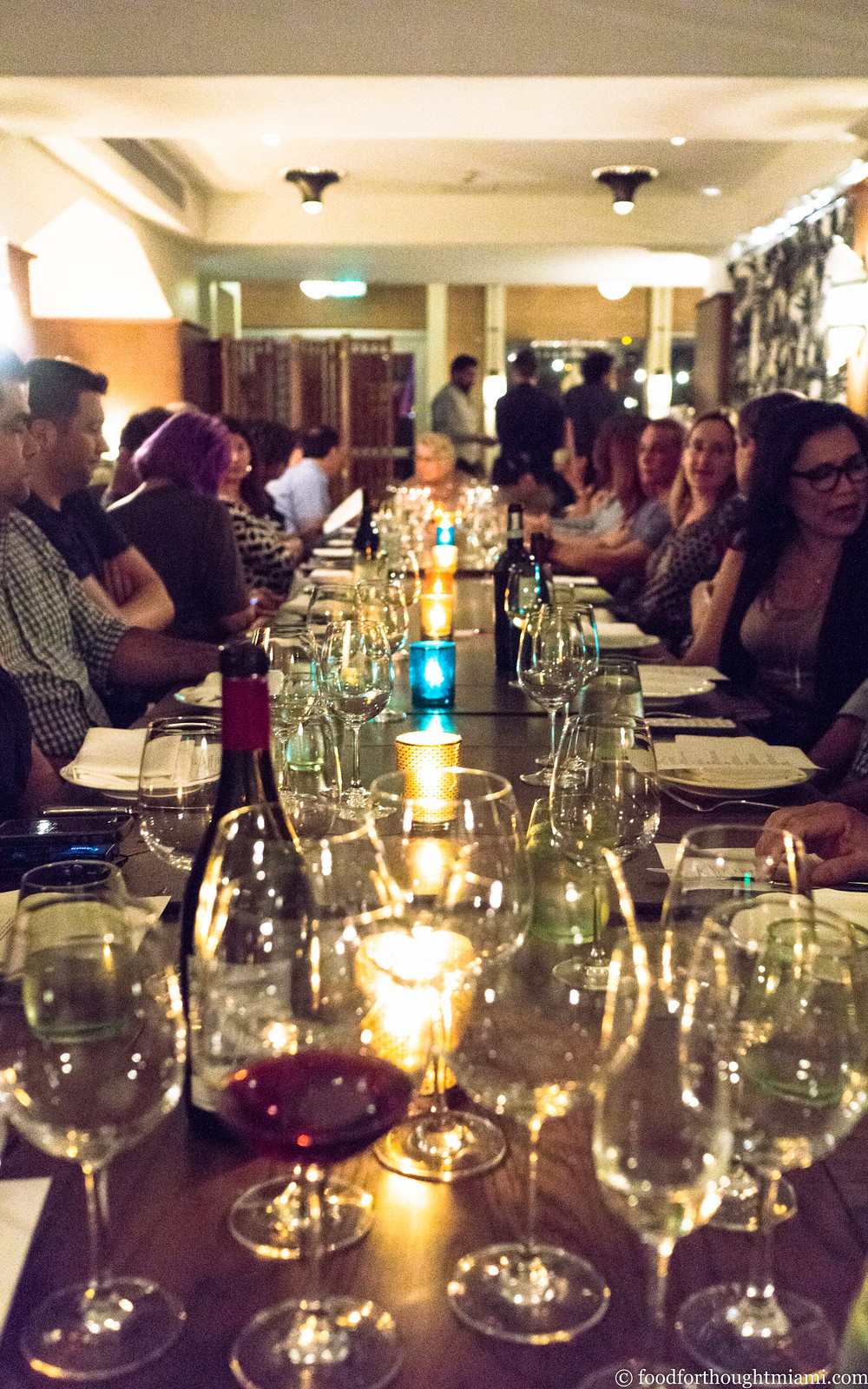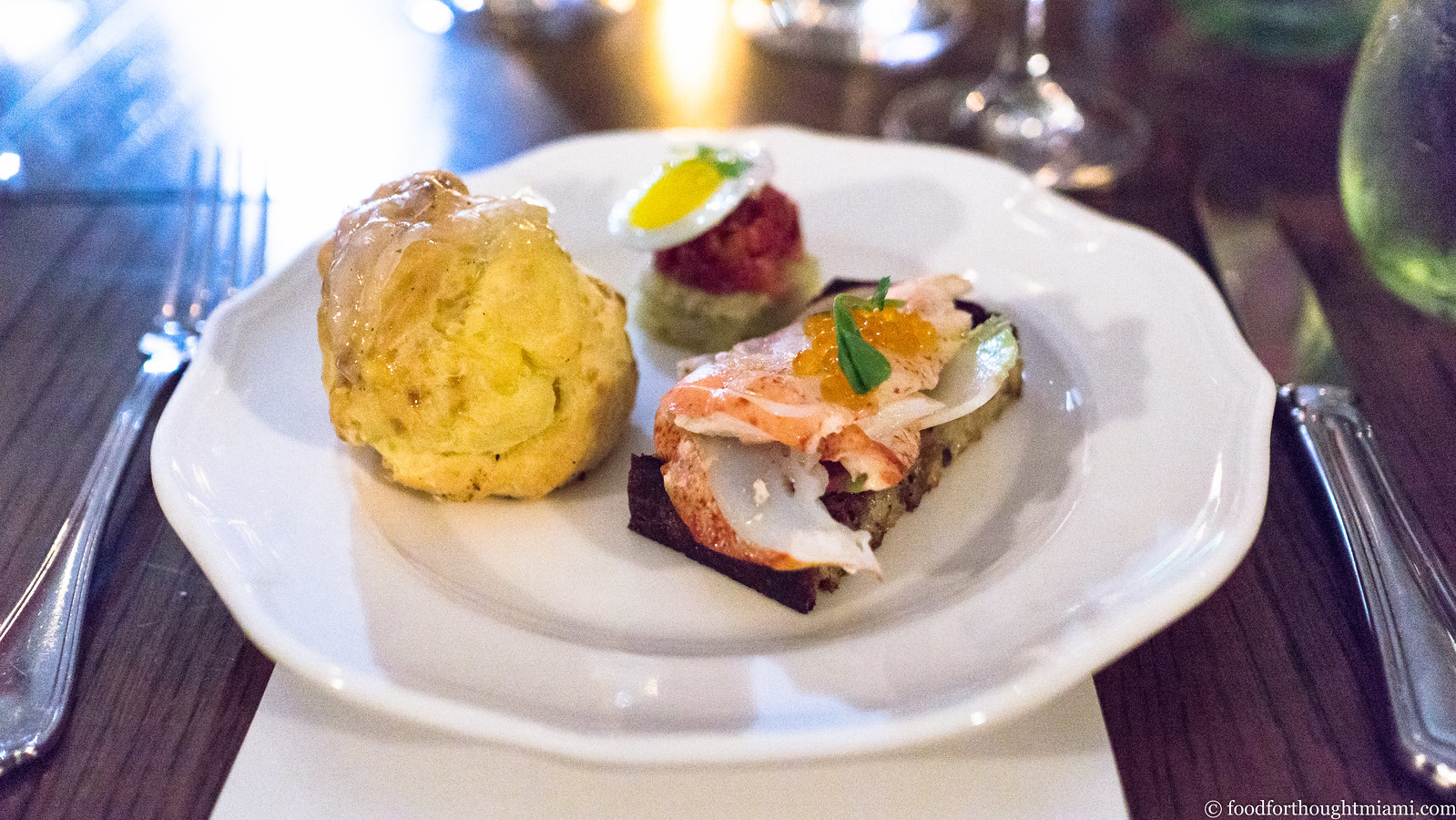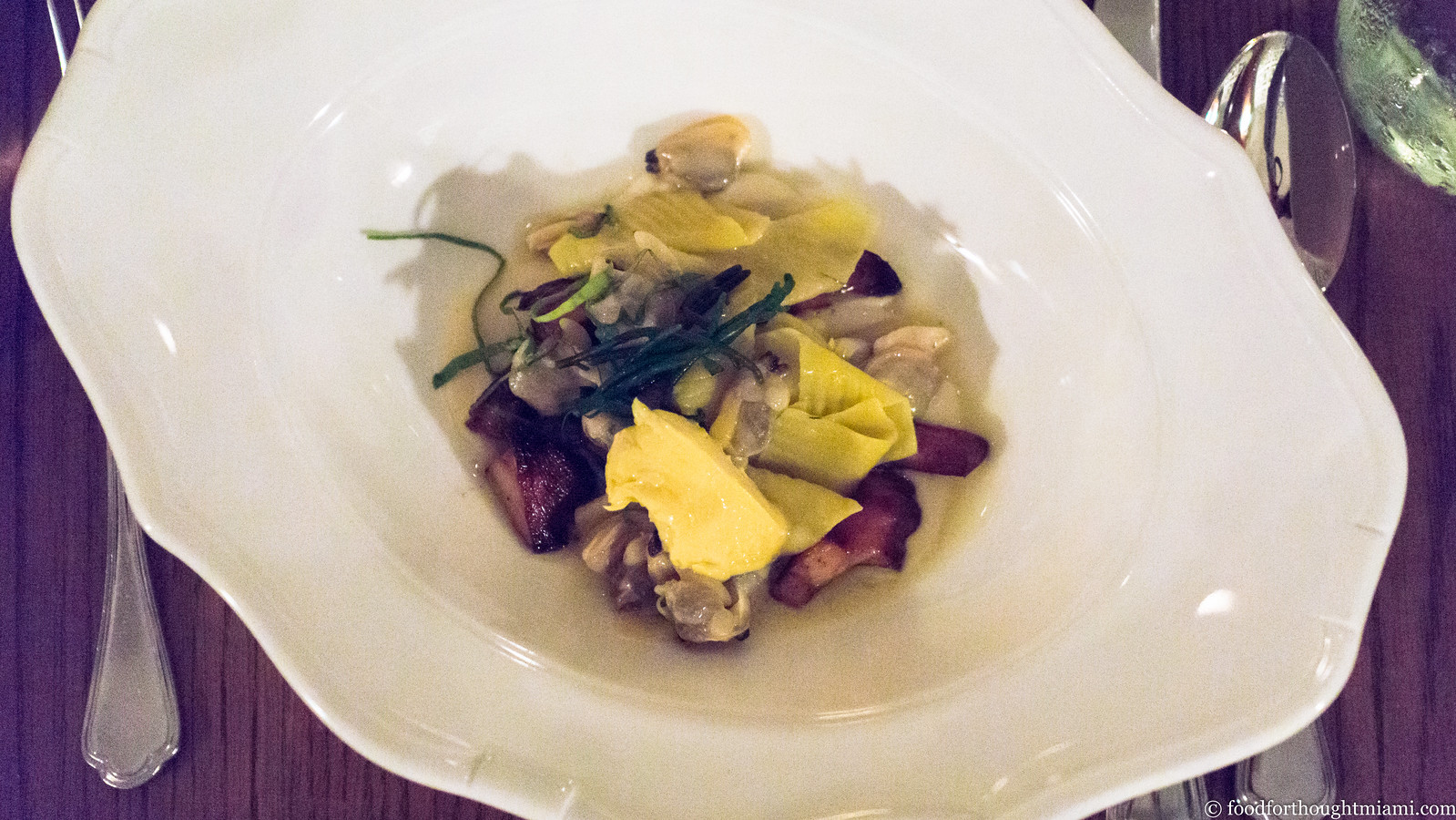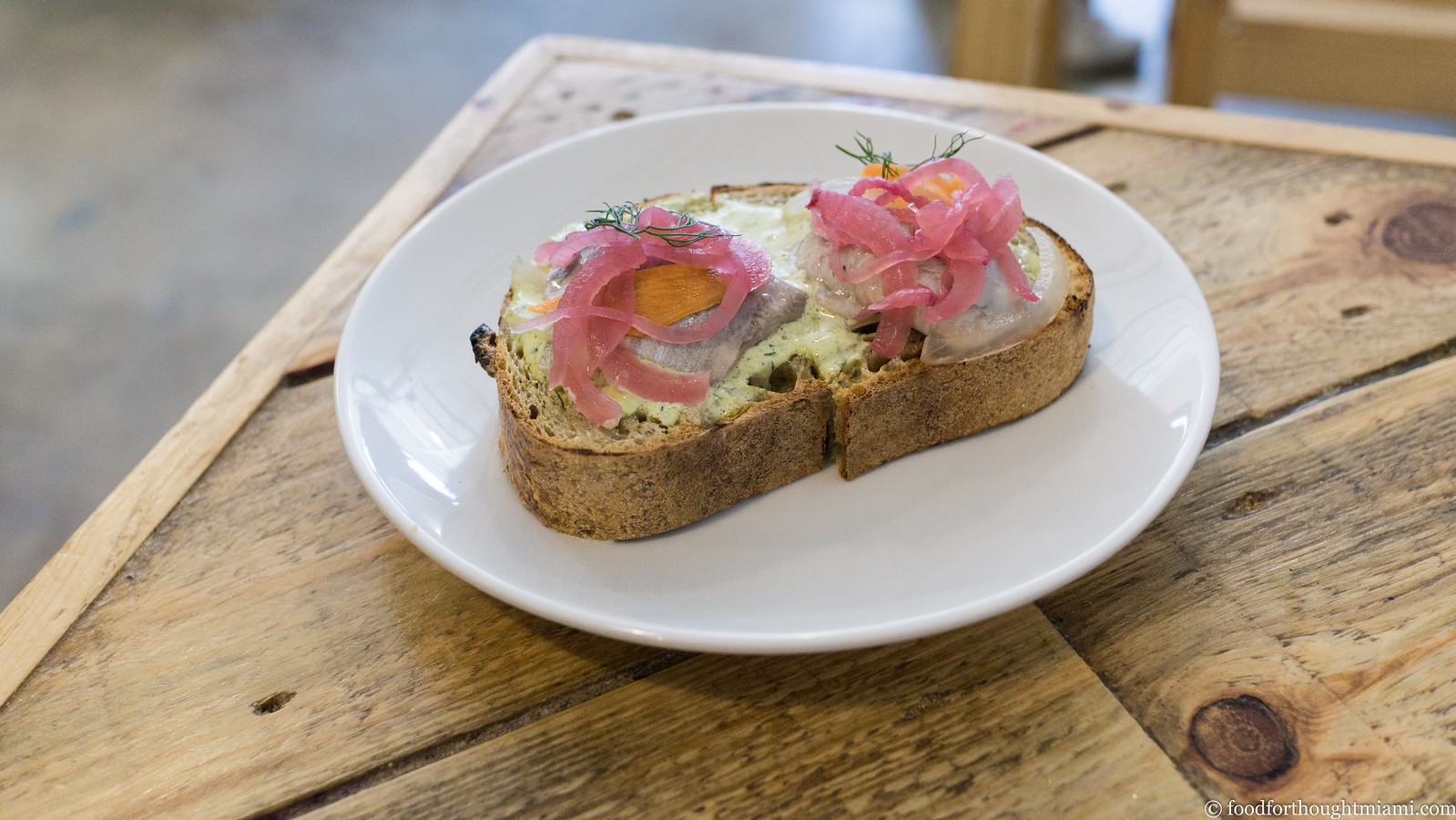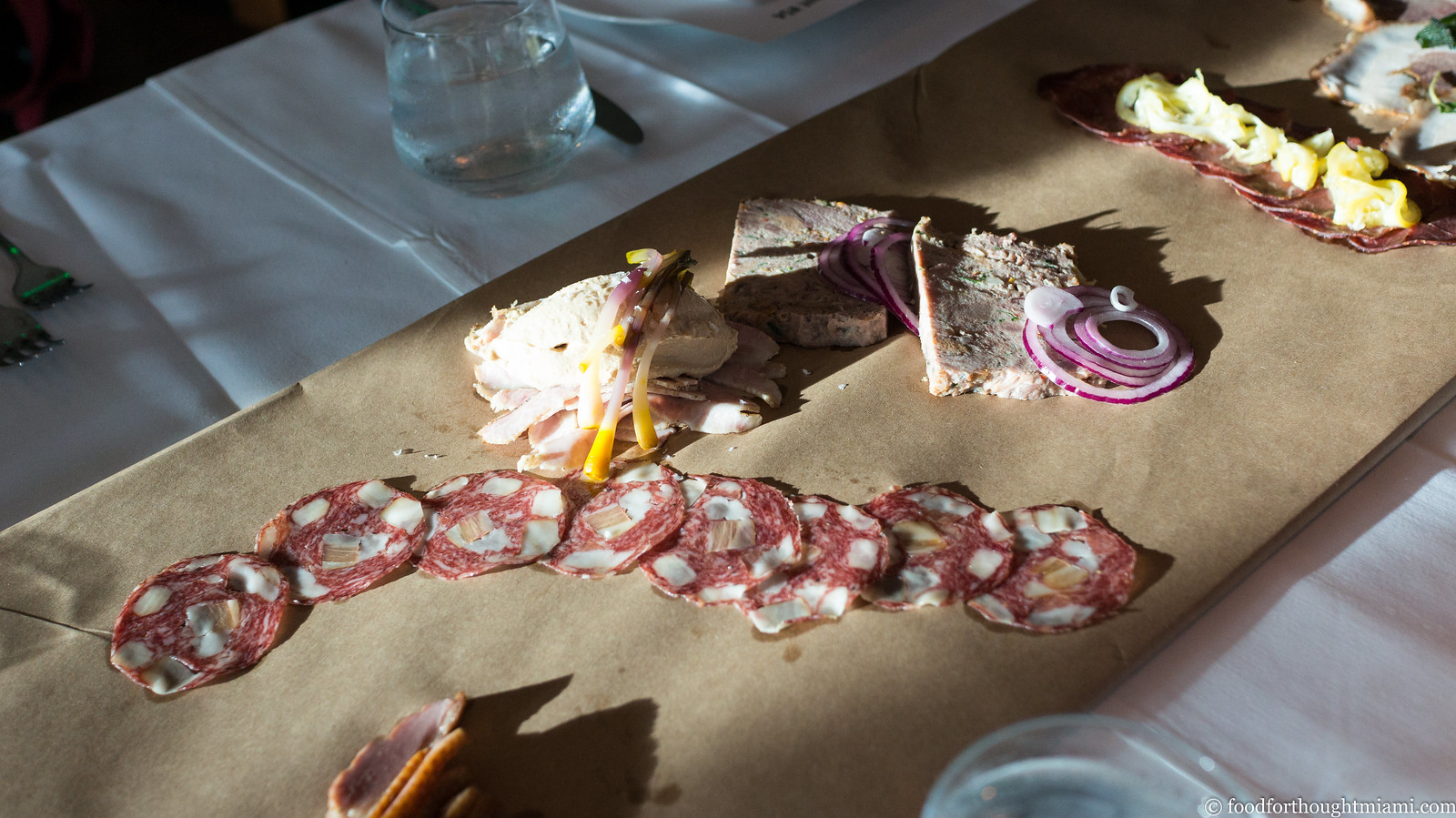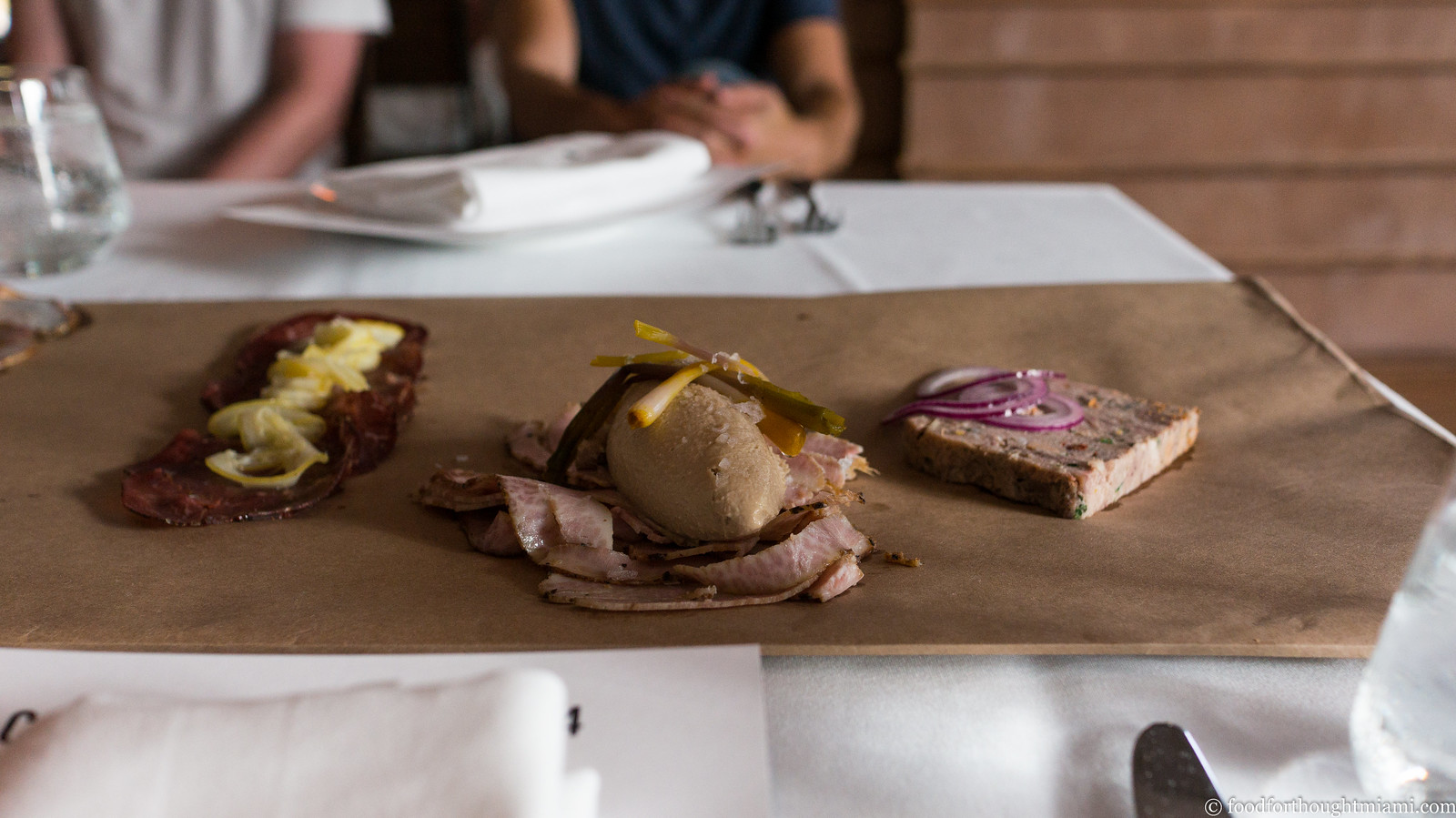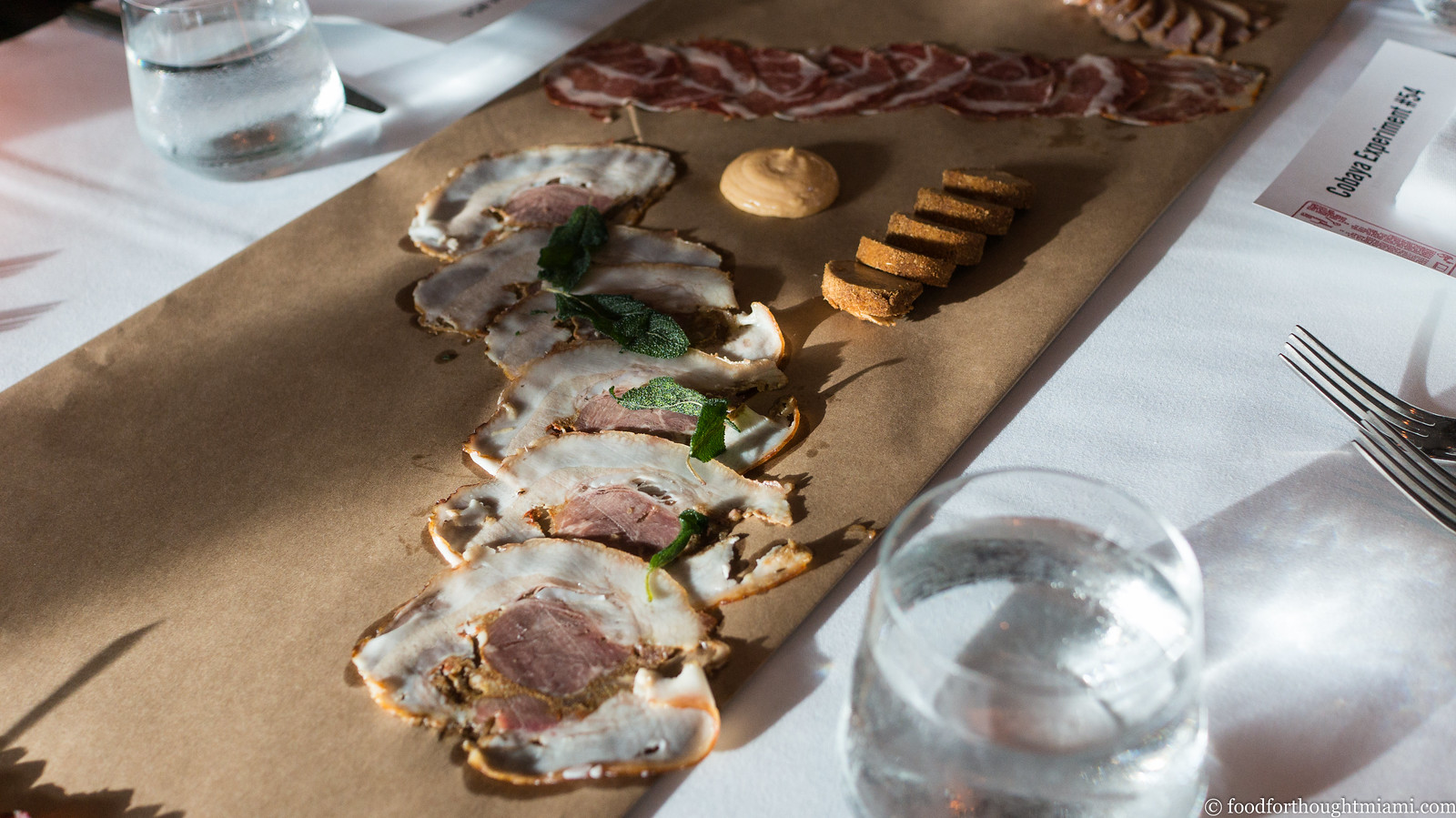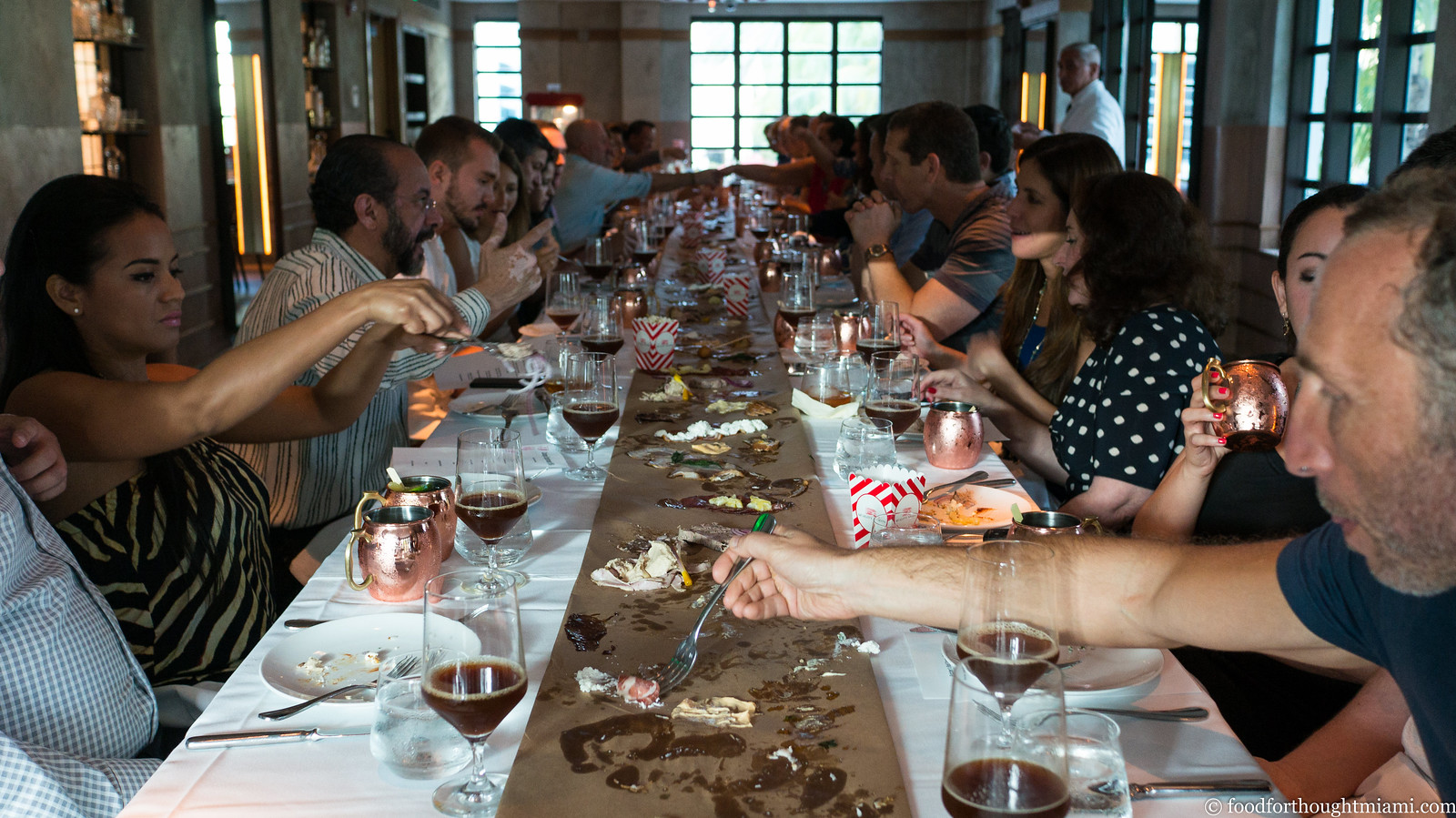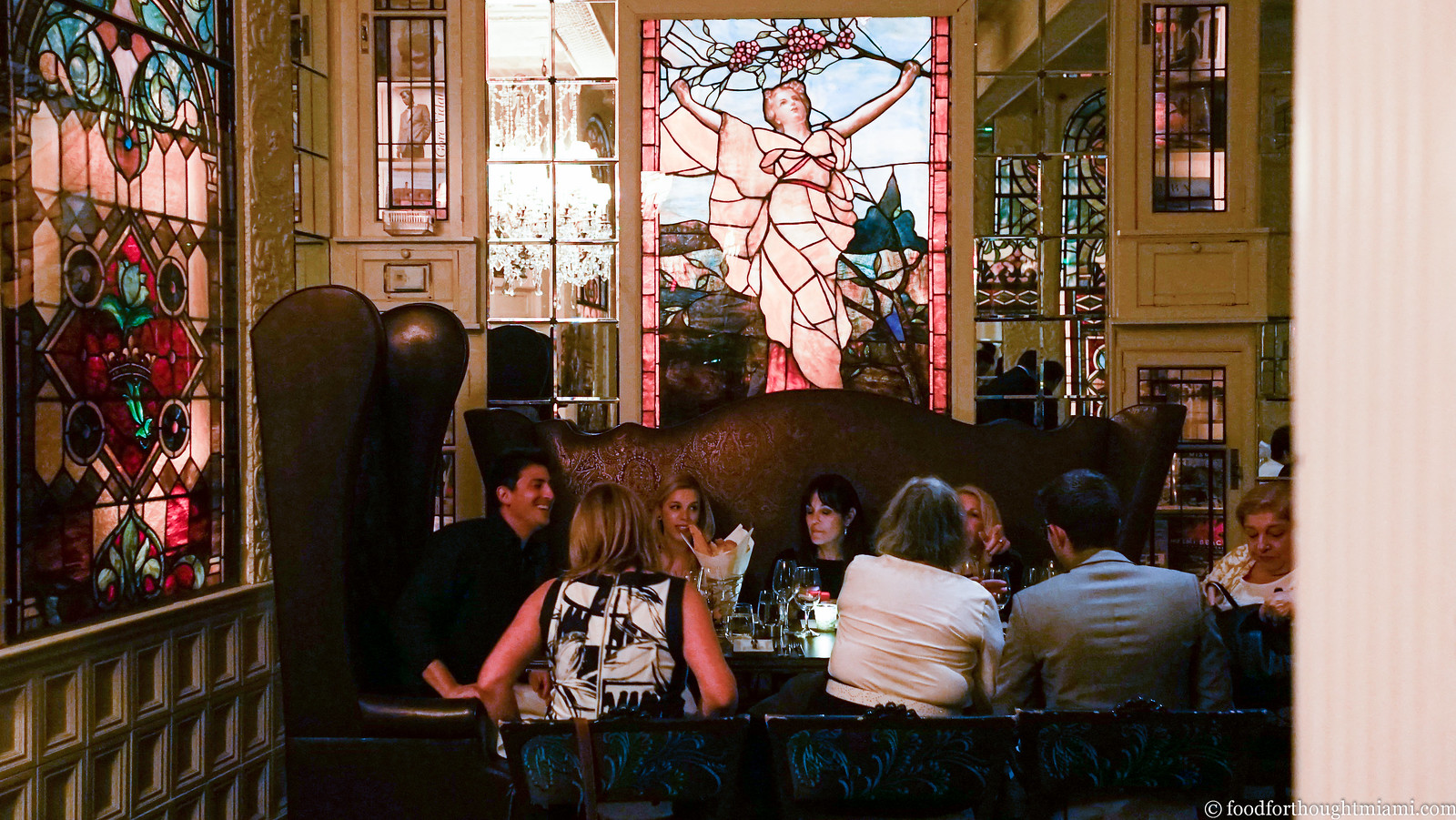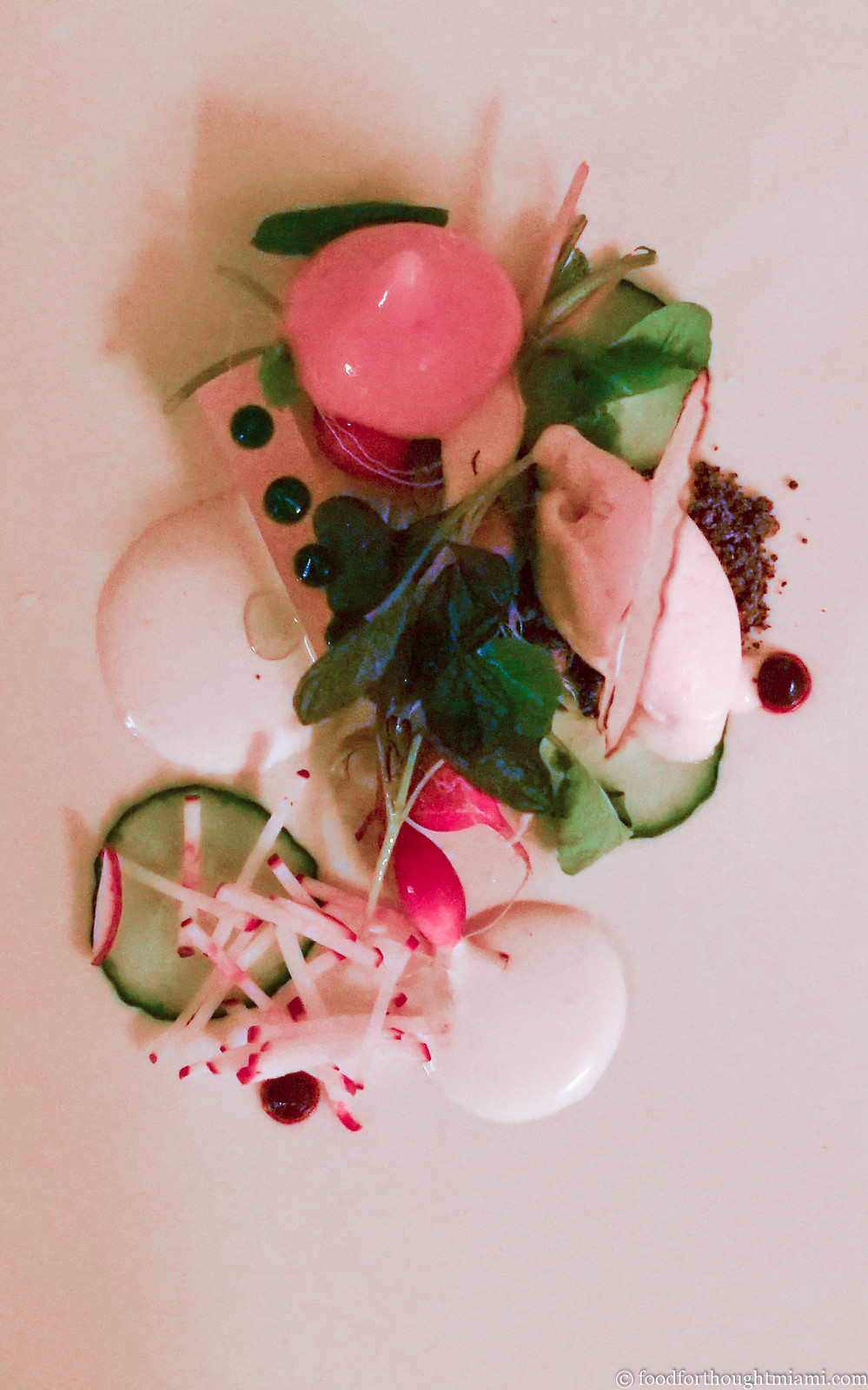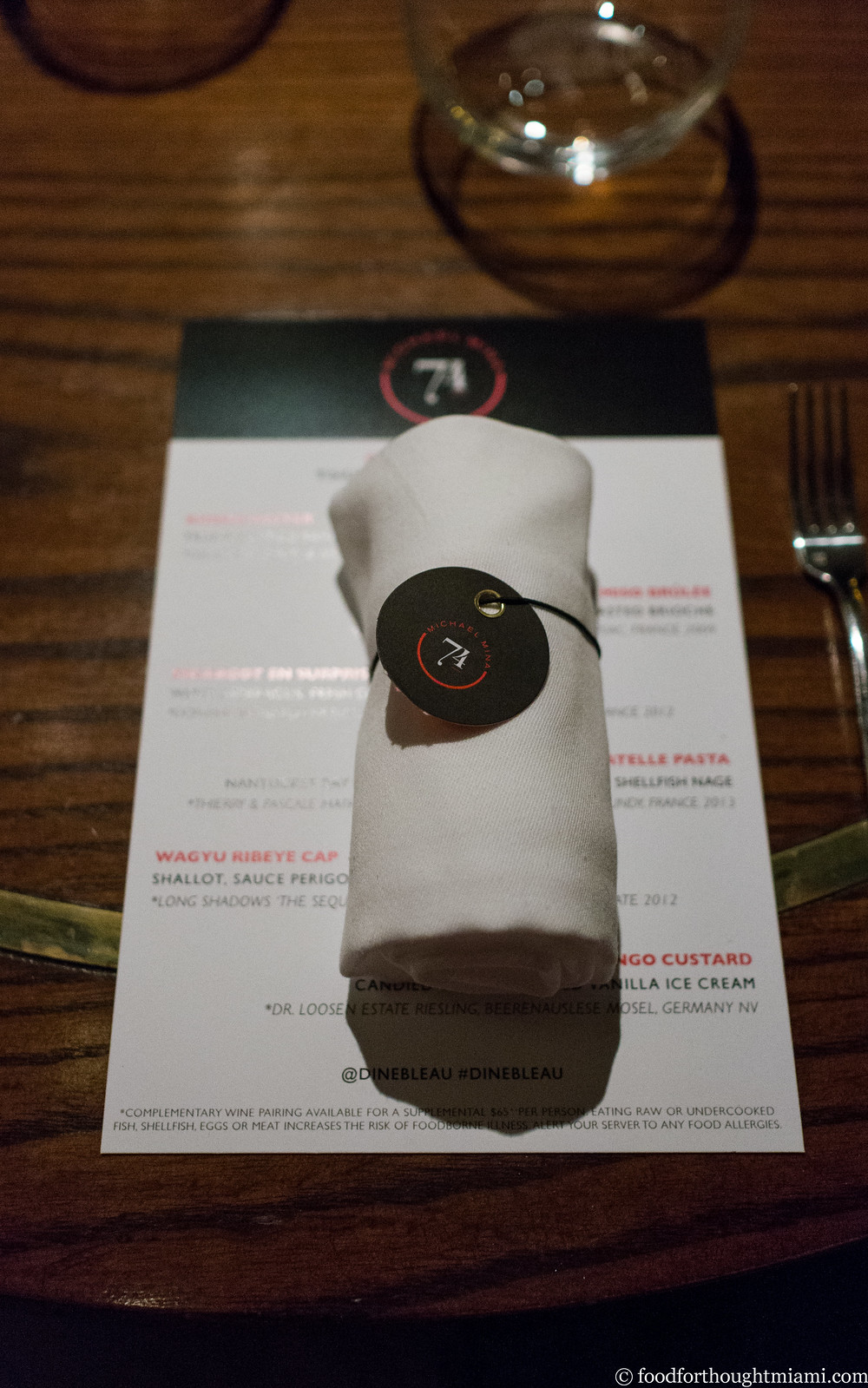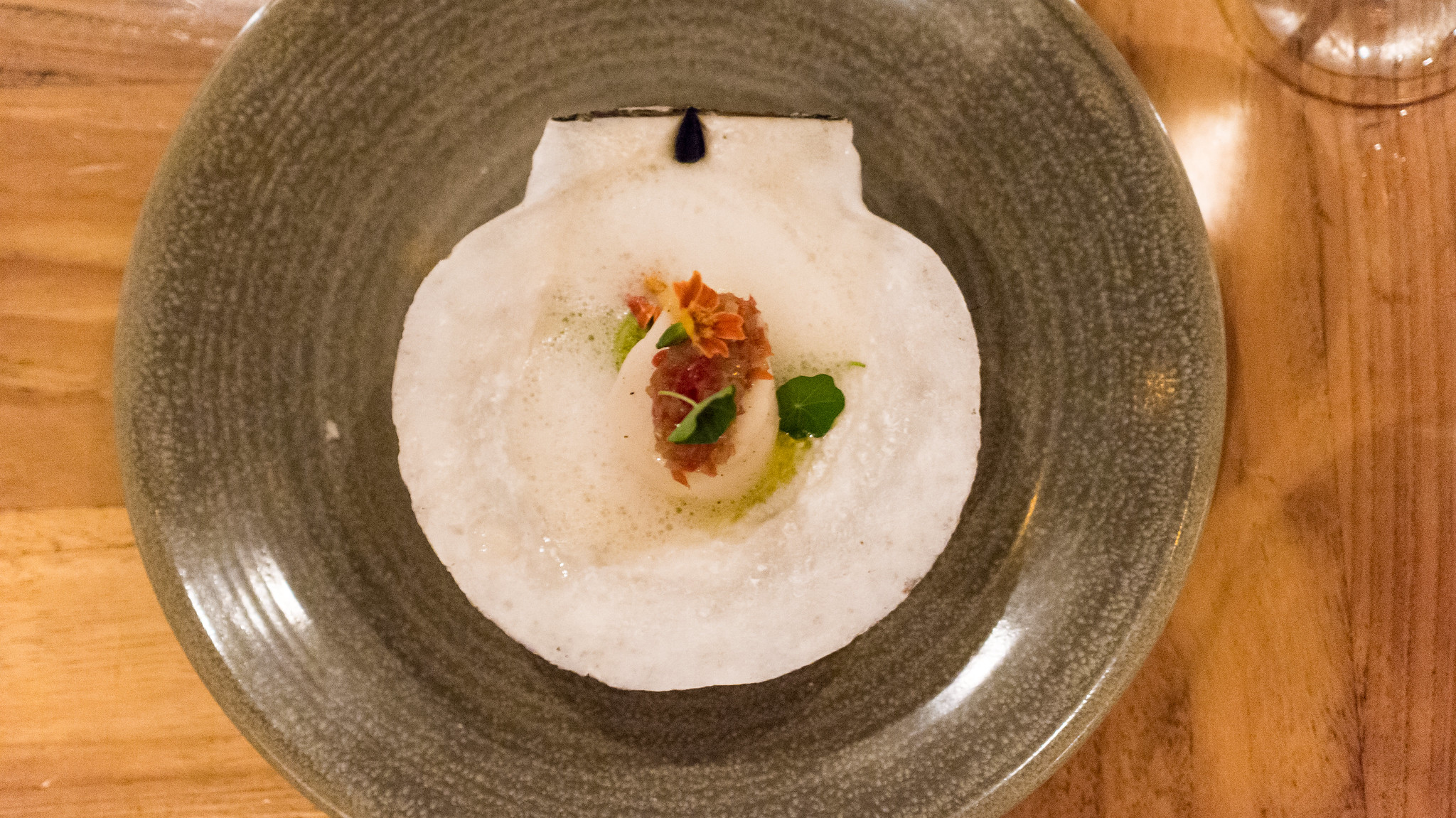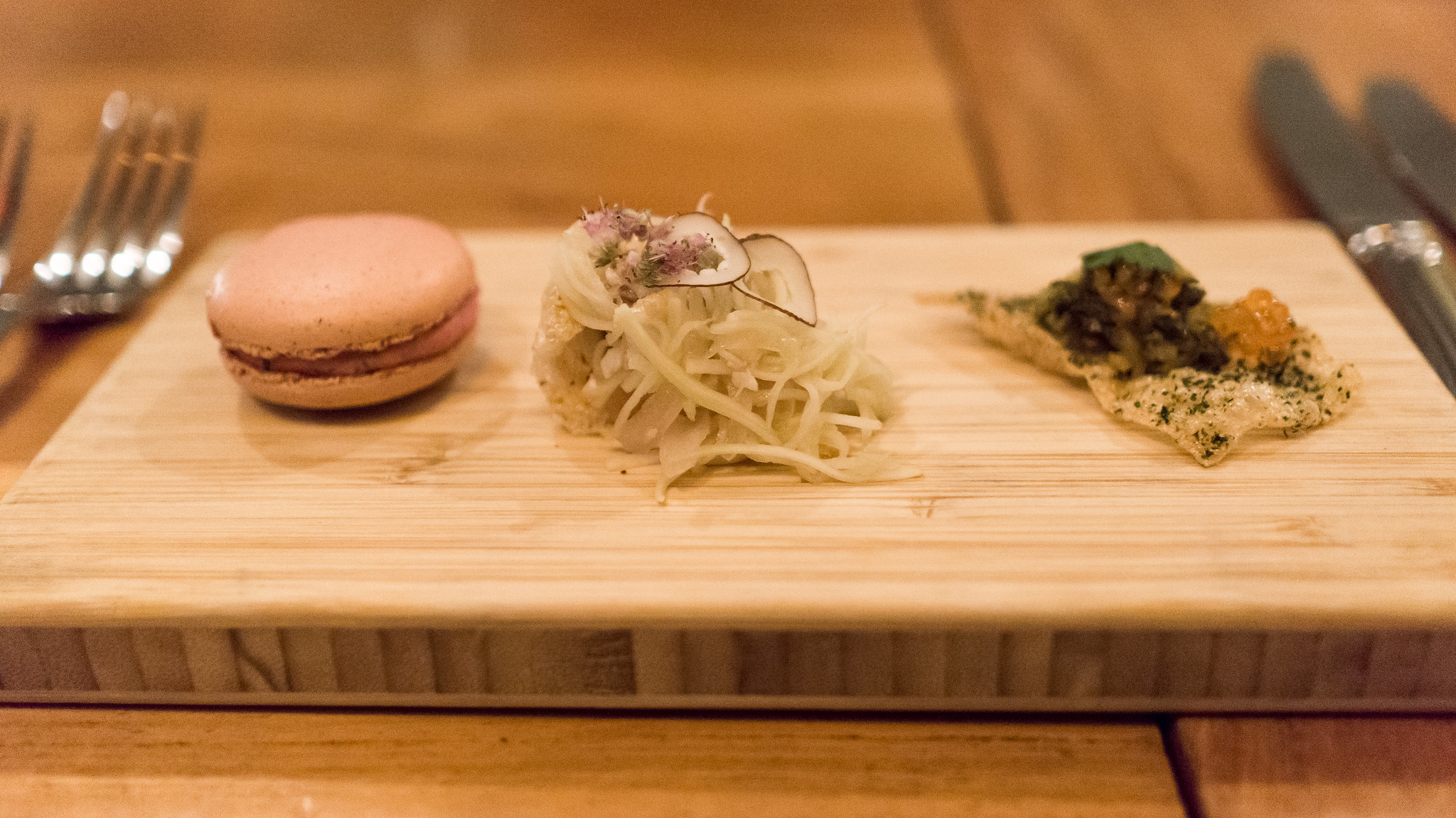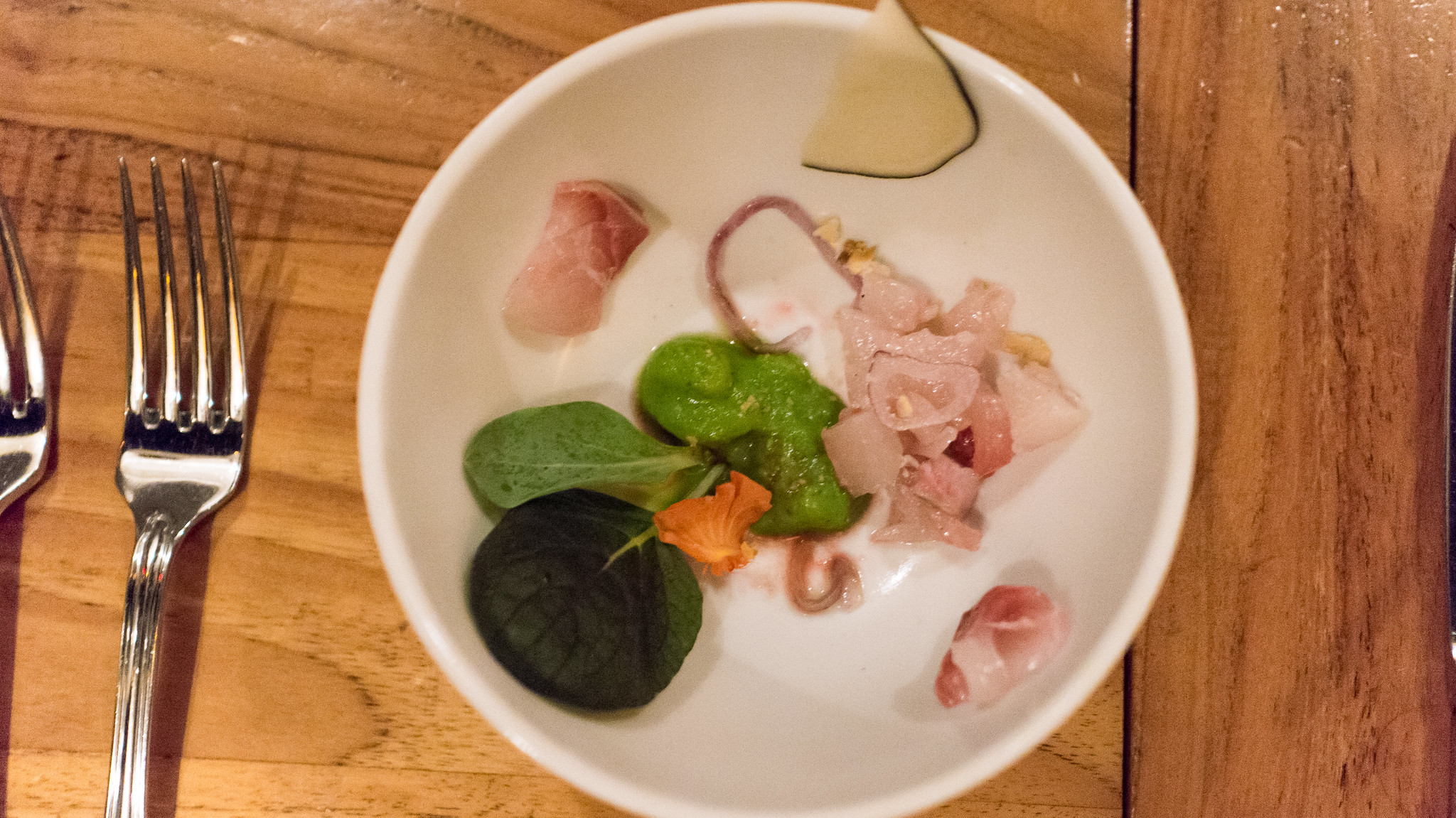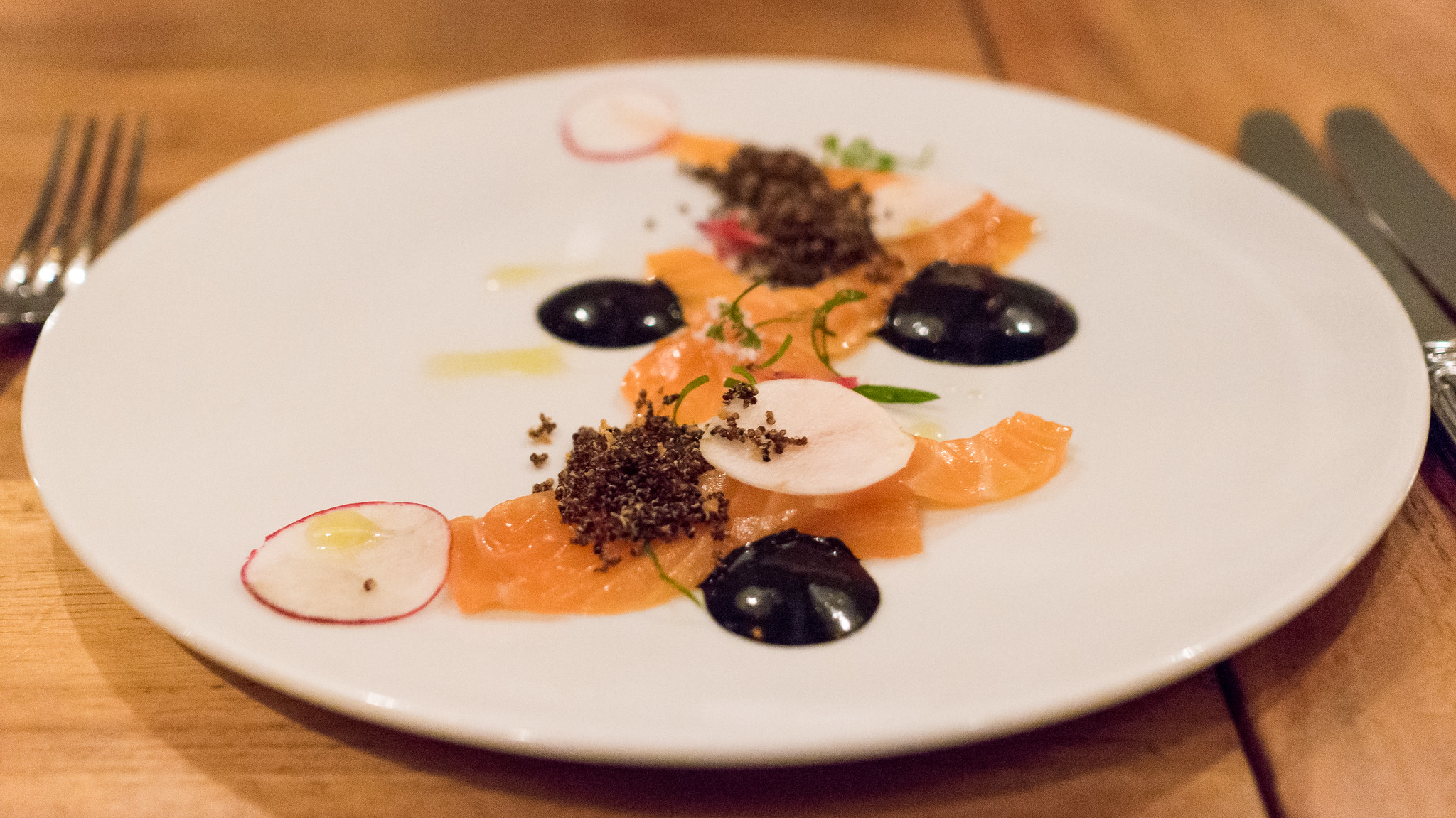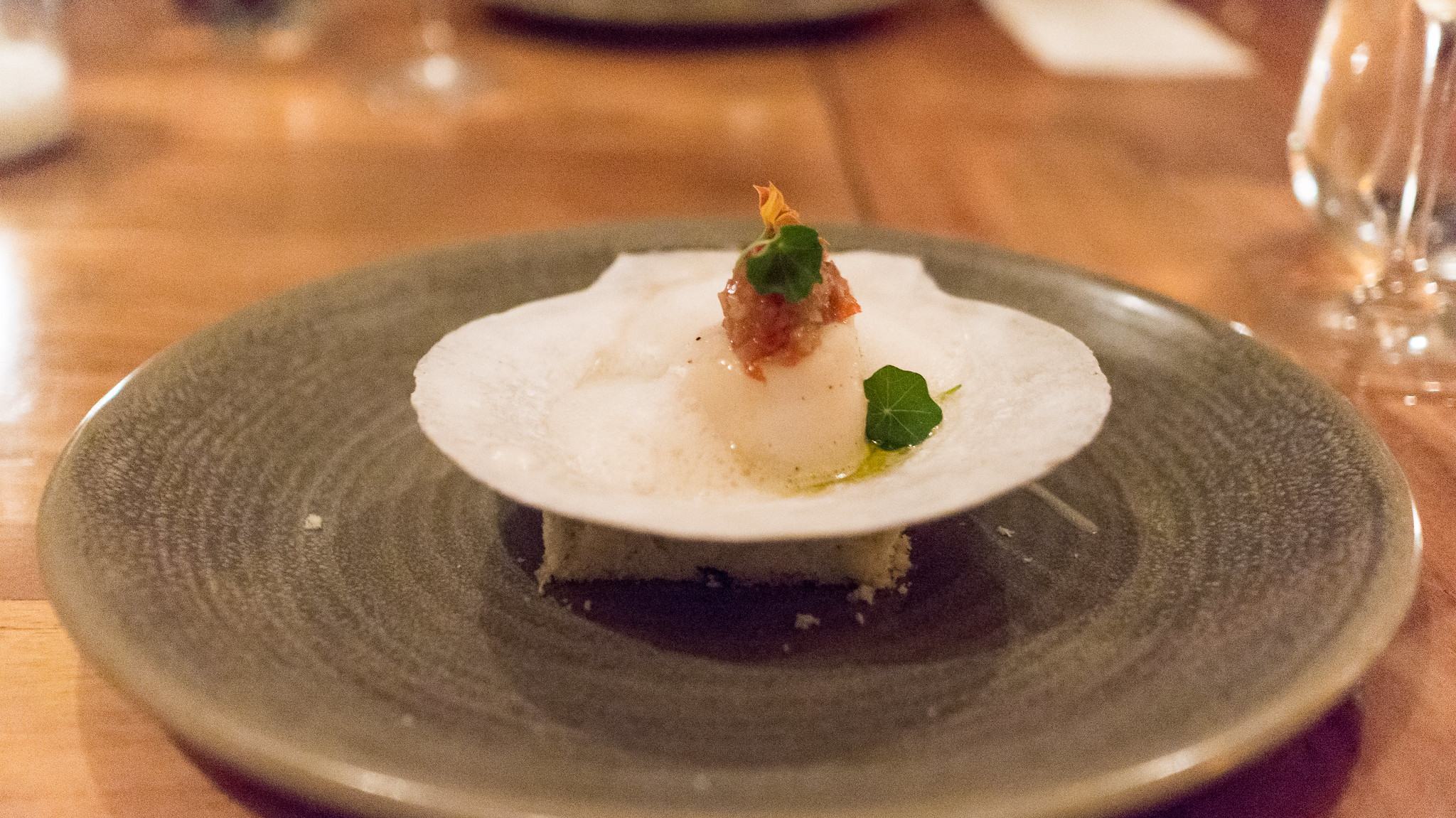Showing posts with label Miami Beach. Show all posts
Showing posts with label Miami Beach. Show all posts
Monday, April 11, 2016
Cobaya #61 at 27 with Chef Jimmy Lebron
This is another one we've been trying to make happen for quite some time. Finally, all the right pieces fell into place and we had a date locked in for a Cobaya dinner at 27 Restaurant, the sibling to the wonderful Broken Shaker bar at the Freehand Hotel on Miami Beach.
27 is one of my favorite places on the Beach, foregoing the glitz and glam that's becoming ever-present for a cozy, homey atmosphere with the feel of an abuela's casita – if your abuela was also Israeli and had a thing for craft cocktails. The regular menu at 27 does a remarkable job of capturing that vibe as well: it's fresh and unfussy, and though visitors may puzzle over why arepas, shakshuka and kimchi fried rice are all coming out of the same kitchen, it somehow tastes and feels more like Miami than just about any other restaurant in town.
The Freehand actually played host to Cobaya #29 with Brandon Baltzley a few years ago, but this one would be an in-house affair. So Chef Jimmy Lebron was in charge, and we invited him to craft his own menu for forty guinea pigs. What he came up with was simultaneously unique and fully in the spirit of the place at the same time.
(You can see all my pictures in this Cobaya #61 at 27 Restaurant flickr set).
We gathered at 27's upstairs bar and sampled the cocktails as the group assembled, then made our way back downstairs and settled in at a few communal tables stretched across the restaurant's multiple rooms. All the courses were served family style, and it had more of the feel of a dinner party than a restaurant meal.
After starting us off with some malawach, a Yemenite fry-bread, served with a really delicious uni butter dusted with za'atar spice, Chef Lebron sent out a round of "Fresh from Florida" seafood courses: Peruvian-inspired steamed middleneck clams swimming in a tangy leche de tigre, with salsa criolla and cancha corn; a crudo of fresh, sweet mangrove snapper, paired with ripe local loquats, tangerine juice, and a surprising – and really magical – dash of Chartreuse; a salad of green papaya from my CSA farmer, Little River Cooperative, with Thai chiles and halloumi cheese, which was one of the best versions I've ever had; and whole black belly rose fish[1] done in an escabeche style, fried whole and topped with pickled vegetables.
(continued ...)
Monday, March 14, 2016
best thing i ate last week: razor clams and rice at Bazi "kaiseki" dinner
I was surprised when I heard that pasta master Michael Pirolo of Macchialina was opening an Asian-inspired restaurant – Bazi. Pirolo's culinary upbringing is Italian through and through. He was raised in Italy, went to culinary school in Torino, and did apprenticeships in Bologna and the Piemonte. The first kitchen he ran as chef de cuisine was Scott Conant's Scarpetta, then he went out on his own with Macchialina (originally opened with the Pubbelly boys, but from whom he split a few years ago).
I didn't see how an Asian restaurant fit with that resume and, to be very candid, figured the motivation was money rather than passion. My theory was thrown into doubt, though, when Bazi recently announced it would start doing a special "kaiseki" style dinner on Wednesday nights for up to eight people at the downstairs bar. Not that $150 per person is exactly giving food away, but considering it's for a ten-course dinner inclusive of drink pairings, tax and tip, it doesn't seem like much of a money-maker either.[1] This is the kind of thing a chef does because they really want to, and maybe because they're a little crazy.
Let's not dwell too long on how much this truly resembles a traditional Japanese kaiseki dinner (short answer: not too much).[2] Instead, let's talk about the best thing I ate last week: the clams and rice dish Pirolo served as one of the courses.
(You can see all my pictures in this Bazi Kaiseki Dinner flickr set).
In this one dish, Pirolo ties together his Italian background and his Japanese ambitions. Diced razor clams are combined with chewy but tender viaolone nano rice, all served in the clam's shell. The rice is prepared in classic "all'onda" fashion, and bound with the clams by an uni vinaigrette which further highlights the flavors of the sea. A shower of fresh lemon balm adds a bright, herbaceous, citrusy note. It's a beautiful dish.
It was a close call between this, the chicken wing stuffed with five-spiced foie gras torchon, the black cod stuffed with Key West shrimp and Alaskan king crab with a nasturtium and avocado purée, and the roasted squab served with a coconut and ginger rice fritter. If that many dishes were in the mix, that's the sign of a pretty good meal. If you're interested, maybe check it out yourself this coming Wednesday.
Bazi
1200 Collins Avenue, Miami Beach, Florida
305.695.0101
[1] Full disclosure: Chowfather and I were guests of the house for this first of their Kaiseki Dinner Series. Had I been spending my own hard-earned dollars, however, I'd still have felt this was a pretty good value. Ten courses, several featuring at least some small doses of luxury ingredients like osetra caviar, uni and foie gras. A pairing with each course by Will Rivas, the talented beverage director of Bazi and Macchialina, including cocktails, sakes (some fruit-infused in-house), smartly selected wines, a rare Japanese beer, and a couple JoJo teas. With tax and tip included. You can spend $150 on a meal in Miami and do far worse.
[2] Longer answer? To my admittedly extremely limited knowledge, most of which is derived from the gorgeous book "Kaiseki" by Yoshihiro Murata (of Kikunoi restaurant) and a couple meals in Japan, there are a few key components to kaiseki. One is the procession of courses, which typically follows a certain pattern though there is some room for variation. Another is the importance of seasonality, with dishes and presentations that attempt to capture a particular moment in time (and consequently are often locally sourced as well). Finally, and linked indelibly to the seasonality component, is the focus on the ingredients themselves; presentations and plating can be rather ornate, but the dishes themselves are often quite elemental – not so much austere as serene, if that makes any sense.
Pirolo's menu paid some heed to the traditional kaiseki progression, without being mindlessly obedient to it. He started with "sakizuke," effectively an amuse-bouche, followed by "hassun," typically an assortment of several different seasonal items, then a sashimi course. Where there are usually then a series of simmered dishes and soups, often followed by a grilled fish, Pirolo took a detour through a series of dishes that didn't really have much traditional antecedent. But whatever – they were some of the best courses of the night. I did miss one of my favorite parts of the typical progression: a rice dish, typically served with pickles and soup, as the final savory item before dessert.
But what I felt was missing more than the progression was the seasonal, local element. There were lots of great dishes; but the ingredients were from literally all over the map, not much of it local, and not seemingly connected much to the season. Perhaps on a related note, too many dishes seemed to be more about the preparations than the ingredients themselves. For instance, with three fish used in the sashimi course, none were local and none were actually served raw: the arctic char was cured, the escolar was marinated in koji, the eel was grilled. This was also probably my least favorite course of the evening; while I have huge respect for Pirolo bringing in live eels and tackling the task of butchering and preparing them from scratch, I'm not convinced the end result is better – or more to the point, more in the spirit of "kaiseki" – than a simple preparation of pristine, fresh local fish.
Personally, I'd love to see a menu that's more about the ingredients, and less about what's been done with them. In this sense, I think Chef Kevin Cory's omakase dinners at Naoe – though he doesn't call them "kaiseki" – are actually much closer to that spirit. And if Pirolo called these "omakase" dinners rather than "kaiseki," I could spend a lot less time spinning wheels in my own head over whether that term really makes any sense here, and instead just focus on the food, which is what I'm really trying to do in this post, other than in this overlong footnote.
[2] Longer answer? To my admittedly extremely limited knowledge, most of which is derived from the gorgeous book "Kaiseki" by Yoshihiro Murata (of Kikunoi restaurant) and a couple meals in Japan, there are a few key components to kaiseki. One is the procession of courses, which typically follows a certain pattern though there is some room for variation. Another is the importance of seasonality, with dishes and presentations that attempt to capture a particular moment in time (and consequently are often locally sourced as well). Finally, and linked indelibly to the seasonality component, is the focus on the ingredients themselves; presentations and plating can be rather ornate, but the dishes themselves are often quite elemental – not so much austere as serene, if that makes any sense.
Pirolo's menu paid some heed to the traditional kaiseki progression, without being mindlessly obedient to it. He started with "sakizuke," effectively an amuse-bouche, followed by "hassun," typically an assortment of several different seasonal items, then a sashimi course. Where there are usually then a series of simmered dishes and soups, often followed by a grilled fish, Pirolo took a detour through a series of dishes that didn't really have much traditional antecedent. But whatever – they were some of the best courses of the night. I did miss one of my favorite parts of the typical progression: a rice dish, typically served with pickles and soup, as the final savory item before dessert.
But what I felt was missing more than the progression was the seasonal, local element. There were lots of great dishes; but the ingredients were from literally all over the map, not much of it local, and not seemingly connected much to the season. Perhaps on a related note, too many dishes seemed to be more about the preparations than the ingredients themselves. For instance, with three fish used in the sashimi course, none were local and none were actually served raw: the arctic char was cured, the escolar was marinated in koji, the eel was grilled. This was also probably my least favorite course of the evening; while I have huge respect for Pirolo bringing in live eels and tackling the task of butchering and preparing them from scratch, I'm not convinced the end result is better – or more to the point, more in the spirit of "kaiseki" – than a simple preparation of pristine, fresh local fish.
Personally, I'd love to see a menu that's more about the ingredients, and less about what's been done with them. In this sense, I think Chef Kevin Cory's omakase dinners at Naoe – though he doesn't call them "kaiseki" – are actually much closer to that spirit. And if Pirolo called these "omakase" dinners rather than "kaiseki," I could spend a lot less time spinning wheels in my own head over whether that term really makes any sense here, and instead just focus on the food, which is what I'm really trying to do in this post, other than in this overlong footnote.
Saturday, March 12, 2016
Cobaya Kamayan with Chef Dale Talde
We encourage chefs to think of a Cobaya dinner as a chance to do something different, something they typically couldn't otherwise pull of in their restaurants. Chef Dale Talde of Talde Miami Beach (and also of Talde Brooklyn, Talde Jersey City, Pork Slope and Thistle Hill) got the message.
(You can see all my pictures in this Cobaya Kamayan with Chef Talde flickr set).
We gathered in the restaurant's bar as our twenty-five guinea pigs made their way to Mid-Beach. Though Talde is inside the Thompson Hotel, it ditches the typical bland, anonymous feel of a hotel restaurant for a hodge-podge of Asian-Americana and hip-hop motifs: behind the hostess stand is a tongue-in-cheek portrait of Talde with a couple bikini-clad models all holding plates of food; one wall is covered with a street art style picture of a tangle of ramen noodles.
As we were assembling our guinea pigs, the Talde crew was getting ready for us, spreading out layers of banana leaves on one long communal table. Though Talde describes his style as "proudly inauthentic" Asian-American cooking, this was going to be a meal with a genuine connection to his Filipino ancestry: a kamayan feast.
What does that mean? From what I can gather from a few minutes of Googling, "kamayan" literally means "with your hands," and derives from a pre-colonial tradition in the Philippines of eating with one's hands. The Spaniards of course saw this as "uncivilized," and brought with them the use of cutlery. But great eating traditions don't die easily, and there is a real pleasure and sense of community in everyone literally digging into a meal with their hands. I've also seen the same thing described as a "boodle fight," referring to a Filipino military custom in the same style where soldiers and officers, regardless of rank, all eat with their hands from the same table.
So as we entered the dining room (after making sure everyone washed their hands), we found one long table covered in banana leaves, and then piled high with dinner for twenty-five. No plates, no utensils, just a lot of food – and a lot of napkins.
(continued ...)
Thursday, March 3, 2016
best thing i ate last week (feb. 15-21): beef, chimichurri, lettuce cores at Alinea Miami pop-up
But the surreal has become real. While their Chicago home, which opened in 2005, gets a facelift, the Alinea team has been doing a traveling road show: first a couple weeks in Madrid, and starting a few weeks ago, a run here in Miami at the Faena Hotel.
(You can see all my pictures in this Alinea in Miami flickr set).
I was there on February 18, the day after the opening, and overall, was very impressed by how well they played for a road game. The menu included both some "greatest hits" from the Alinea oeuvre – hot potato cold potato, black truffle explosion, the bacon trapeze – as well as a few items that took inspiration from the local flavors.
From this latter category came my favorite dish of the evening, and of the week. To save a bit of the mystery of the dinner, I won't tell how the steak was cooked, other than to say that sometimes things are hidden in plain view. But I will say that the tranche of crimson-hued wagyu beef was paired with a bright tangy green emulsion inspired by Argentinian chimichurri, complemented by my favorite item on the plate: spears of crunchy, tart pickled lettuce cores, a really effective use of an unheralded and unexpected ingredient.
Although the Alinea Miami dinners have been reported as sold out for several weeks, when I checked this morning a few open spots were showing up in their ticketing system for this weekend and next. If you're intrigued, you may want to jump on those quickly.
Thursday, February 25, 2016
best thing i ate last week (feb. 8-14): chow fun with braised pork and mustard greens at Talde Miami Beach
I still have little hope of keeping up with the pace of Miami restaurant openings, but lately I've made a small dent in the list. Saturday before last, I braved my way through Miami Boat Show traffic to visit Talde Miami Beach, Chef Dale Talde's new restaurant in the Thompson Hotel (OK, maybe not even so new any more - it opened in November).
(You can see all my pictures in this Talde Miami Beach flickr set).
Where its companion in the Thompson, Michelle Bernstein's Seagrape, harmonizes with the hotel's 1950's, Morris Lapidus vibe, Talde brings a little of Chef Talde's Brooklyn home base to the beach: half the seating is in a re-purposed shipping container, graffiti covers the walls, hip hop blares over the speakers. The menu is similar to the chef's Brooklyn outpost which also bears his name, and features a hodge-podge of unabashedly inauthentic "Asian-American" dishes: kung pao chicken wings, pretzel pork and chive dumplings and the like.
It's a refreshingly casual place in a part of the beach that is becoming increasingly fancy. Prices are not exactly cheap, but they aren't ridiculous either, especially the short list featured on the "Late Night Noodles" menu from midnight to 4am on Thursdays to Saturdays for the club kids crowd.
I took a spot at the small kitchen counter that lines the back of the restaurant, where I tried a few things including one real standout: Talde's chow fun with braised pork and mustard greens. The broad rice noodle is given an unusual presentation, rolled in a tight spiral and seared on its top surface, the idea being that you break up the noodle and mix it with the rest of the components at the table. It makes for a great combination of crispy and chewy. The noodle, once given some encouragement, is an effective vehicle for the flavors of the tender braised pork, a broth that's redolent of sweet soy (and possibly Chinese fermented black beans), and some pleasantly tangy pickled mustard greens that provide much-wanted brightness.
I'll be back soon to try the Benton's bacon dumplings and the Korean fried chicken with spicy kimchi yogurt.
(You can see all my pictures in this Talde Miami Beach flickr set).
Where its companion in the Thompson, Michelle Bernstein's Seagrape, harmonizes with the hotel's 1950's, Morris Lapidus vibe, Talde brings a little of Chef Talde's Brooklyn home base to the beach: half the seating is in a re-purposed shipping container, graffiti covers the walls, hip hop blares over the speakers. The menu is similar to the chef's Brooklyn outpost which also bears his name, and features a hodge-podge of unabashedly inauthentic "Asian-American" dishes: kung pao chicken wings, pretzel pork and chive dumplings and the like.
It's a refreshingly casual place in a part of the beach that is becoming increasingly fancy. Prices are not exactly cheap, but they aren't ridiculous either, especially the short list featured on the "Late Night Noodles" menu from midnight to 4am on Thursdays to Saturdays for the club kids crowd.
I took a spot at the small kitchen counter that lines the back of the restaurant, where I tried a few things including one real standout: Talde's chow fun with braised pork and mustard greens. The broad rice noodle is given an unusual presentation, rolled in a tight spiral and seared on its top surface, the idea being that you break up the noodle and mix it with the rest of the components at the table. It makes for a great combination of crispy and chewy. The noodle, once given some encouragement, is an effective vehicle for the flavors of the tender braised pork, a broth that's redolent of sweet soy (and possibly Chinese fermented black beans), and some pleasantly tangy pickled mustard greens that provide much-wanted brightness.
I'll be back soon to try the Benton's bacon dumplings and the Korean fried chicken with spicy kimchi yogurt.
Sunday, February 21, 2016
WeWork Miami & Food Panel Discussion - Monday February 22 6pm
Pop-up panel alert! Come out on Monday and see me do my best to moderate a discussion about the present and future of Miami's food and cocktail world with some of my favorite people in the business: Brad Kilgore of Alter, Steve Santana of Taquiza, Jessica Sanchez of Loba, and Elad Zvi of Bar Lab and Broken Shaker.
We'll all be at WeWork, located at 350 Lincoln Road, Miami Beach, on Monday February 22, starting at 6pm through 8pm. Please RSVP to RSVP@workshopcollective.com if you're coming, thanks.
We'll all be at WeWork, located at 350 Lincoln Road, Miami Beach, on Monday February 22, starting at 6pm through 8pm. Please RSVP to RSVP@workshopcollective.com if you're coming, thanks.
Thursday, December 24, 2015
first thoughts: Pao by Paul Qui in the Faena Hotel - Miami Beach
Of the many big-name Miami restaurant openings of late, the one I've been most curious about is Paul Qui's Pao in the Faena Hotel Miami Beach. I've followed the chef since he was in the kitchen at Austin's Uchi, watched him dominate a season of Top Chef and win a James Beard Award in 2012, then go on to open both a tasting menu format restaurant (Qui) and several ragingly successful food trucks in Austin (East Side King and its sibling Thai-Kun, which was on Bon Appetit's list of best new restaurants of 2014).
Pao is Qui's first venture outside of Austin, and it's a big one: the Faena is perhaps the most ostentatious and over-the-top of many recent ostentatious, over-the-top Miami developments. The billion dollar project includes not only the hotel, where rooms start at $900 a night, but also a Norman Foster-designed condominium where units are selling for an average of $3,000 per square foot (including a $60 million sale to a billionaire hedge fund manager) and the Rem Koolhaas-designed Faena Forum, a multi-disciplinary arts exhibition center.
It is both exciting and, in a way, alienating. In many respects, I simply don't recognize this as the city where I was born and have spent nearly half a century. Faena, and other recent projects like the expansion of the Design District into what seems like a living catalog of the holdings of LVMH, are designed as playgrounds for the über-wealthy, international jet-set; they have little connection to the locals who actually live here.
But if it brings chefs like Qui to Miami, then who am I to complain?
Oddly, despite all the hullabaloo over Faena, details on Qui's restaurant have been somewhat hard to come by, even as it opened at the beginning of this week. I heard the food would be "modern Asian" with "Filipino, Spanish, Japanese and French flavors;" I heard a lot more about the $6 million Damien Hirst gold-leafed unicorn sculpture ("Golden Myth") that is the centerpiece of the dining room. But that's OK: so many restaurants put out so much pre-opening hype these days that I grow tired of hearing about them before they've even opened. By contrast, I didn't have much of an idea of what to expect heading into Pao. So here's a first look.
(You can see all the pictures from my first visit to Pao – including shots of the menu, which is not yet available online – in this Pao by Paul Qui flickr set).
The menu starts with four choices of fish crudos, along with a "binchotan service" featuring several items that can be grilled tableside over Japanese charcoal. It then moves through about a half-dozen choices of small plates, several rice dishes and a selection of several larger-format plates meant for sharing.
The first item on the menu points toward Qui's Filipino heritage: kinilaw, the Philippines' version of ceviche. Slices of hiramasa (a/k/a buri, yellowtail, amberjack) are bathed in coconut milk and coconut vinegar, garnished with hearts of palm and slivered red onion, and dappled with Spanish olive oil. It's richer, and less acidic, than a typical ceviche, and I found myself wishing the vinegar was turned up a little louder than the coconut milk. The other crudo we tried, a carpaccio of Japanese sea bream, was plated with a puddle of smoked soy sauce and leek oil contained within a ring of kumquat jam that tasted as bright and vibrant as its vivid orange hue. The quality of the fish was excellent, but I was somewhat surprised that of the four crudos offered, none came from local waters
(continued ...)
Monday, October 19, 2015
Cobaya Seagrape with Chefs Jason Schaan and Tony Velazquez
It's hard for me to believe that it was more than four years ago that one of my favorite chefs, Michelle Bernstein, agreed to do a Cobaya dinner with us. Not that the folks who had done the eleven dinners before her were slouches, but here was one of Miami's most celebrated chefs: a James Beard award winner running one of the top restaurants in town. This, for us, was the big leagues.
Even now, with more than forty more "experiments" under our collective belts (which may be set to a wider notch these days), that dinner in the atrium of the Melin Building still stands out as one of the most memorable – not just for the food (which was excellent) but for Michelle's eagerness to do it and the grace with which it was executed.
But for Experiment #56, though we were in Seagrape, the restaurant in the Thompson Hotel that Bernstein opened last year, it would not be her dinner. Rather, the spotlight was on Jason Schaan, the hotel executive sous chef, and Tony Velazquez, the restaurant's chef de cuisine. Schaan goes way back with Michelle: he worked the line when she was at Azul and made his way up to CDC at Michy's (and was also in the kitchen for that Cobaya dinner back in 201). Velazquez is a recent addition to the team, but another Cobaya veteran, having worked at 1500° when they did Experiment #27.
The menu Schaan and Velazquez put together was a fitting match to the mid-century modern style of the venue, balancing classical elegance with some contemporary flourishes.
(You can see all my pictures in this Cobaya Seagrape flickr set; unfortunately the lighting situation was far from ideal and my pictures are pretty awful).
Once we were all settled into a private dining area next to the main dining room, a trio of canapes started things off. A puffy gougère, draped with a sheet of translucent lardo, concealed a molten core of gooey, mushroom-y L'Explorateur cheese. Tender ribbons of Maine lobster were draped over toast slathered with salted butter, given fresh crunch by shaved radishes and briny pop by a dollop of trout caviar. Rich Masami wagyu beef belly tartare, perked up with some chorizo, was mounded onto a round of brioche, drizzled with bearnaise sabayon, and topped with a fried quail egg.
I love a good vitello tonnato, the classic Italian dish that combines cold, thinly sliced veal with a caper-flecked mayo gone piscine with the addition of canned tuna. I know, it seems like it would be awful, but for reasons I can't quite explain, it all works. So I was intrigued to see Jason and Tony do a variation with brussels sprouts, with that funky, fishy quality amplified by a shaving of bottarga over the top.
(continued ...)
Even now, with more than forty more "experiments" under our collective belts (which may be set to a wider notch these days), that dinner in the atrium of the Melin Building still stands out as one of the most memorable – not just for the food (which was excellent) but for Michelle's eagerness to do it and the grace with which it was executed.
But for Experiment #56, though we were in Seagrape, the restaurant in the Thompson Hotel that Bernstein opened last year, it would not be her dinner. Rather, the spotlight was on Jason Schaan, the hotel executive sous chef, and Tony Velazquez, the restaurant's chef de cuisine. Schaan goes way back with Michelle: he worked the line when she was at Azul and made his way up to CDC at Michy's (and was also in the kitchen for that Cobaya dinner back in 201). Velazquez is a recent addition to the team, but another Cobaya veteran, having worked at 1500° when they did Experiment #27.
The menu Schaan and Velazquez put together was a fitting match to the mid-century modern style of the venue, balancing classical elegance with some contemporary flourishes.
(You can see all my pictures in this Cobaya Seagrape flickr set; unfortunately the lighting situation was far from ideal and my pictures are pretty awful).
Once we were all settled into a private dining area next to the main dining room, a trio of canapes started things off. A puffy gougère, draped with a sheet of translucent lardo, concealed a molten core of gooey, mushroom-y L'Explorateur cheese. Tender ribbons of Maine lobster were draped over toast slathered with salted butter, given fresh crunch by shaved radishes and briny pop by a dollop of trout caviar. Rich Masami wagyu beef belly tartare, perked up with some chorizo, was mounded onto a round of brioche, drizzled with bearnaise sabayon, and topped with a fried quail egg.
I love a good vitello tonnato, the classic Italian dish that combines cold, thinly sliced veal with a caper-flecked mayo gone piscine with the addition of canned tuna. I know, it seems like it would be awful, but for reasons I can't quite explain, it all works. So I was intrigued to see Jason and Tony do a variation with brussels sprouts, with that funky, fishy quality amplified by a shaving of bottarga over the top.
(continued ...)
Friday, October 16, 2015
best thing i ate last week: pasta "vongole" at Cobaya Seagrape
A bit behind schedule here, as it's already Friday, but better late than never. Last Tuesday we held our 56th Cobaya dinner, this time with chefs Jason Schaan and Tony Velazquez at Michelle Bernstein's Seagrape in the Thompson Hotel on Miami Beach. A full update will be coming shortly, but here let me just talk about my favorite dish of the night: their pasta vongole. This was no garden variety linguine and clam sauce. Here was hand rolled garganelli nestled among a couple different kinds of clams (manila clams and venus clams), batons of salsify and roasted mushrooms, a tangle of sea beans, with a generous knob of silky, oceanic uni butter mounted on top as it was served. It was a great mix of surf and earth, and the best thing I ate last week.
Thursday, October 1, 2015
best thing i ate last week: grilled carrots with aged gouda and buckwheat at Eating House
Somehow, I had let a year go by since my last visit to Eating House, Giorgio Rapicavoli's pop-up gone permanent on the northern edge of Coral Gables. That was dumb of me. This past weekend I grabbed a solo spot at the bar after both wife and daughter had abandoned me for the evening, and sampled as much as I could of the current menu. Some staples remain: the tomatoes with coconut ice and Vietnamese flavors, the chicken and "foi-ffles," the over-the-top pasta carbonara. But everything else around the edges is new – and very good.
Vegetable-focused dishes in particular are a strong suit, and of these, my favorite was a plate of grilled carrots, blanketed in soft curls of a powerfully rich five-year aged gouda cheese (it gets crystals like a good aged parmigiano-reggiano), dappled with crunchy buckwheat kernels, all resting atop a pillow of a creamy carrot-top pesto. I especially liked that the carrots were not annihilated, but maintained a not-quite-raw but still firm core – so you get both clean, vegetal snap and dark, sweet roasty caramel flavors. It was the best thing I ate last week.
Runners-up: the blistered shishito peppers showered with cured egg yolk and dry olive at Eating House; the flaky malawach bread (a Yemenite specialty) served with spicy hariff, grated tomatoes, feta cheese and hard boiled egg for brunch at 27 Restaurant (especially good when accompanied by a Miso Honey Cold Brew).
Monday, September 21, 2015
best thing i ate last week: schmaltz herring toast at Zak the Baker
It was the first thing I ate at Zak the Baker when the Wynwood café opened last May: a toasted slab of his fantastically crusty, naturally leavened multigrain bread, topped with slick, fatty brined schmaltz herring and pickled onions. On that first visit, it was paired with a 10 a.m. vodka shot which Zak rightfully insisted was an essential accompaniment.
This past Sunday morning, there was mercifully no hard liquor, but there was that same delicious fish, that same delicious bread, those same tart onions, though a pickle-infused aioli substituted for the creamy creme fraiche of that first visit. Still mighty good. And the best thing I ate last week. Pro tip: ZTB gets crazy busy with Sunday brunchers, but still keeps baker's hours, and opens at 7 a.m. If you can rouse yourself early, you may be able to squeeze in before the crowds.
Runner up: a classic from chef Michelle Bernstein's repertoire, on the menu at her Miami Beach restaurant, Seagrape: a delicately fried squash blossom stuffed with shrimp mousseline, served over a bed of creamy corn grits and dappled with a rich seafood nage.
Monday, July 6, 2015
best thing i ate last week: charcuterie at Quality Meats
It wasn't any one thing in particular (though they were all pretty excellent); it was the sheer joyous abundance and variety of the charcuterie spread that Chef Patrick Rebholz laid out for his Cobaya dinner at Quality Meats last Tuesday.
There was a smoked soppressata, topped with a cornbread cream. There was suckling pig coppa di testa, topped with fried sage leaves. Cured foie gras torchon, rolled in malted barley and a mango gastrique. A hearty pork headcheese with rounds of slivered onion. Hickory smoked duck bacon. Coppa, topped with aerated mozzarella. Calf liver mousse with pickled ramps. Merguez "prosciutto" topped with preserved lemon. Pork jowl corn dogs with tabasco mayo. Popcorn drizzled with melted dry-aged beef fat. All of it made in-house, all laid out up and down a roll of butcher's paper stretched along a forty foot table as we entered the room.
It was the best thing I ate last week. (You can read more about the dinner here).
There was a smoked soppressata, topped with a cornbread cream. There was suckling pig coppa di testa, topped with fried sage leaves. Cured foie gras torchon, rolled in malted barley and a mango gastrique. A hearty pork headcheese with rounds of slivered onion. Hickory smoked duck bacon. Coppa, topped with aerated mozzarella. Calf liver mousse with pickled ramps. Merguez "prosciutto" topped with preserved lemon. Pork jowl corn dogs with tabasco mayo. Popcorn drizzled with melted dry-aged beef fat. All of it made in-house, all laid out up and down a roll of butcher's paper stretched along a forty foot table as we entered the room.
It was the best thing I ate last week. (You can read more about the dinner here).
Friday, July 3, 2015
Quality Cobaya with Chef Patrick Rebholz
The scent – well, let's be more blunt – ripe, animal funk of cured meats as we entered the room was a good sign. It soon became apparent from whence it came: a spread of charcuterie laid on top of butcher paper that stretched all the way down a table set for forty guests.
We were in a private second-floor room in the old Bancroft Hotel on South Beach, a beautiful property whose Art Deco features have been pretty respectfully preserved. It's now the home of the Miami outpost of Quality Meats, a New York restaurant with some historical legacy itself: its owners opened the original Smith & Wollensky steakhouse in New York in 1977.[1]
The chef was Patrick Rebholz. Before joining QM, Rebholz had spent most of the past decade cooking in Charleston, most recently as the chef de cuisine at the Peninsula Grill. We got a hint that Chef Rebholz had big plans for his Cobaya dinner when he asked for an early start time. Sure enough, we didn't wrap up until nearly four hours after our 6:30pm commencement. It was time very happily spent.
(You can see all my pictures from the dinner in this Quality Cobaya flickr set).
After milling around at the bar while our group assembled, we were escorted upstairs to the "Bancroft Room" and its wafting meaty aromas. Moscow Mules in gleaming copper mugs were handed out to everyone. All the chairs were pushed back from the table so that Rebholz and crew could more easily make their way through to apply some finishing touches: cornbread cream on top of the smoked soppressata; aerated mozzarella on top of the coppa.
There was plenty more: silky, intense cured foie gras torchon coated with malted barley and a mango gastrique; thin-sliced suckling pig coppa di testa and hearty headcheese; merguez "prosciutto" topped with preserved lemon; creamy calf liver mousse topped with pickled ramps; pork jowl pastrami; hickory smoked duck bacon; toasty pork jowl corn dogs with Tabasco mayo; popcorn dressed in dry-aged beef fat. Rebholz poured some of his house-brewed beer too, and it was a great match with the charcuterie.[2]
It was a crazy good way to start a meal, and folks dug in pretty rapaciously. Then Chef Rebholz just rolled the paper down to clear the table.[3]
(continued ...)
We were in a private second-floor room in the old Bancroft Hotel on South Beach, a beautiful property whose Art Deco features have been pretty respectfully preserved. It's now the home of the Miami outpost of Quality Meats, a New York restaurant with some historical legacy itself: its owners opened the original Smith & Wollensky steakhouse in New York in 1977.[1]
The chef was Patrick Rebholz. Before joining QM, Rebholz had spent most of the past decade cooking in Charleston, most recently as the chef de cuisine at the Peninsula Grill. We got a hint that Chef Rebholz had big plans for his Cobaya dinner when he asked for an early start time. Sure enough, we didn't wrap up until nearly four hours after our 6:30pm commencement. It was time very happily spent.
(You can see all my pictures from the dinner in this Quality Cobaya flickr set).
After milling around at the bar while our group assembled, we were escorted upstairs to the "Bancroft Room" and its wafting meaty aromas. Moscow Mules in gleaming copper mugs were handed out to everyone. All the chairs were pushed back from the table so that Rebholz and crew could more easily make their way through to apply some finishing touches: cornbread cream on top of the smoked soppressata; aerated mozzarella on top of the coppa.
There was plenty more: silky, intense cured foie gras torchon coated with malted barley and a mango gastrique; thin-sliced suckling pig coppa di testa and hearty headcheese; merguez "prosciutto" topped with preserved lemon; creamy calf liver mousse topped with pickled ramps; pork jowl pastrami; hickory smoked duck bacon; toasty pork jowl corn dogs with Tabasco mayo; popcorn dressed in dry-aged beef fat. Rebholz poured some of his house-brewed beer too, and it was a great match with the charcuterie.[2]
It was a crazy good way to start a meal, and folks dug in pretty rapaciously. Then Chef Rebholz just rolled the paper down to clear the table.[3]
(continued ...)
Wednesday, May 13, 2015
Cobaya Lee at the Forge
The Forge is one of the true grand dames of the South Florida restaurant world. And like a lot of grand dames, it's had a bit of work done here and there over the years. Originally opened in the 1930's, it was the mid-century Miami hangout of choice for celebrities like Frank Sinatra and Jackie Gleason. In the 1960's, Alvin Malnik bought it from the original owner (a blacksmith, ergo the name), and remodeled it in the luxe, rococo style that has become its signature. Malnik – with a little help from Baron Philippe Rothschild – also was responsible for filling out its encyclopedic wine cellar. In the 1990's, after son Shareef Malnik took over from his father, the Forge was not only regarded as one of the city's top restaurants – it also was one of Miami's hottest party scenes with its Wednesday disco nights.
Since then, it's had at least one more substantial redecoration about five years ago, lightening up some of that old polished mahogany. It has brought some new life into the kitchen as well: Dewey LoSasso did a turn there, and more recently Chef Christopher Lee took over the reigns. Chef Lee has a pretty full résumé for a guy who's still in the prime years of his career: in 2005 he was the James Beard "Rising Star Chef of the Year;" the following year, after moving from Philadelphia to New York, he garnered two Michelin stars for (now-closed) Gilt; then a couple years later picked up another Michelin star at Aureole.[1]
So when Chef Lee expressed an interest in doing a Cobaya dinner, we were intrigued to see what he was doing these days – and eager to have an excuse to hang out in one of Miami's most opulent dining settings.
(I am abashed at the lousy quality of my photos from this dinner; I was trying out a new camera and am very disappointed with the results. So with my apologies, you can see all the pictures from this dinner in this Cobaya Forge flickr set).
Chef Lee started light, with a dish featuring radishes in a multitude of fresh, snappy, peppery forms, accompanied by puddles of a tangy goat cheese dressing and a quenelle of a bright orange and fennel sorbet.
(continued ...)
Tuesday, March 31, 2015
Cobaya Griese at MM74
Thomas Griese is the chef at MM74, a Michael Mina restaurant in the Fontainebleau resort in Miami Beach. It's a "dressy casual" kind of venue, someplace you might go to before heading to Liv (or maybe even after clubbing: it's open until 2am on weekends) and get anything from hamachi "poppers" to a $26 burger to Mina's classic lobster pot pie. Don't get me wrong, the food at MM74 is good – very good, in many instances – but you wouldn't expect a high end, classically French inspired dining experience there.
But that's what Chef Griese did for his Cobaya dinner, drawing inspiration from his stage at The French Laundry and other fine dining venues[1] to put together a meal that was as luxurious and fancy as any we've had.
(You can see all my pictures in this Cobaya Griese at MM74 flickr set).
The theme was set from the start as we settled into several tables cloistered in the back of the subterranean restaurant downstairs in the Fontainebleau (our first actual "underground" dinner). A kusshi oyster blanketed in a silky truffled yuzu sabayon, with a dollop of osetra caviar perched on top, was a subtle nod to Keller's classic "Oysters and Pearls."[2] That striking lurid blue is from infusing curaçao into the salt on which the oyster is plated.
From oysters, caviar and truffles to foie gras, of course: in the form of a crème brûlée, blended with mellow white miso. Brioche toast soldiers with slivers of banana and some fresh herbs and flowers were plated alongside for dunking into the creamy custard after you pierced through its burnished sugar cap, with dots of a sweet ruby port reduction circling the dish. The combination of liver, miso and banana might sound unlikely but made perfect sense: a matching of similarities instead of contrasts, with their rich, creamy, unctuous qualities merging into something positioned right between savory and sweet.
(continued ...)
Tuesday, January 13, 2015
CobaYeo at Khong River House
For Cobaya experiment #47, we returned to the site of experiment #30, almost exactly two years ago: Khong River House, just off Lincoln Road on Miami Beach. In the interim, there had been changes in the kitchen – owner John Kunkel had lured Chef Patricia Yeo down from Chicago to head up the restaurant – and we were excited to see what was new.
Chef Yeo worked with Bobby Flay at several of his New York restaurants before opening several of her own places, first in New York and then Boston, including Om and Moksa. In 2012, she left Boston to join Chicago's Lettuce Entertain You group, for which she served as creative director of a fast-casual Asian mini-chain, Big Bowl. Some of you may also remember her from her appearance on Bravo's Top Chef Masters show. She only recently joined Khong and has been in the process of making its menu her own.
But when we do Cobaya dinners, we don't want the restaurant menu, and I was happy that Chef Yeo did not constrain herself. Rather, she put together a "belly" themed menu for our dinner featuring some form of belly in each course.
(You can see all my pictures in this CobaYeo flickr set).
To start things off: clam bellies. Served family style for the table to share, these plump, juicy clams were lightly battered and fried, together with a zingy aioli spiked with lemon and capers. I've paid one visit to Khong since Chef Yeo took over, and from my limited sample size, this dish (even though there was nothing Asain about it) is characteristic of her style: very bright, defined flavors. There's an angularity rather than a roundness to her cooking, if that makes any sense: you taste each component distinctly and vividly.
(continued ...)
Chef Yeo worked with Bobby Flay at several of his New York restaurants before opening several of her own places, first in New York and then Boston, including Om and Moksa. In 2012, she left Boston to join Chicago's Lettuce Entertain You group, for which she served as creative director of a fast-casual Asian mini-chain, Big Bowl. Some of you may also remember her from her appearance on Bravo's Top Chef Masters show. She only recently joined Khong and has been in the process of making its menu her own.
But when we do Cobaya dinners, we don't want the restaurant menu, and I was happy that Chef Yeo did not constrain herself. Rather, she put together a "belly" themed menu for our dinner featuring some form of belly in each course.
(You can see all my pictures in this CobaYeo flickr set).
To start things off: clam bellies. Served family style for the table to share, these plump, juicy clams were lightly battered and fried, together with a zingy aioli spiked with lemon and capers. I've paid one visit to Khong since Chef Yeo took over, and from my limited sample size, this dish (even though there was nothing Asain about it) is characteristic of her style: very bright, defined flavors. There's an angularity rather than a roundness to her cooking, if that makes any sense: you taste each component distinctly and vividly.
(continued ...)
Thursday, October 23, 2014
Elements: Scott Anderson Dinner at The Dutch
Much as I might wish for it, I don't get to spend my days traversing the country from restaurant to restaurant. We're fortunate to travel often and usually eat very well when we do, but even so, there are places I'm unlikely to ever visit. Princeton, New Jersey would fall into that category.[1] And as a result, I figured I would never eat at Elements, Chef Scott Anderson's restaurant which opened in Princeton about five years ago (and is currently closed while moving to a new location).
This was cause for regret, because I'd read and heard many very good things about it. A couple guys whose opinions I value raved about their meals there. Despite being somewhat off the grid, it was highly regarded enough to make Opinionated About Dining's list of the top twenty restaurants in the U.S. So I was pretty excited when I learned, through Chef Jeremiah Bullfrog, that Scott was interested in doing a dinner here in Miami.
We sent up some Cobaya flares for other folks who might be interested, and Chef Conor Hanlon of The Dutch graciously agreed to participate and play host. Together, Scott, Jeremiah, Conor and Josh Gripper, The Dutch's pastry chef, put together a pretty extraordinary ten-course dinner.
(You can see all my pictures in this Chef Scott Anderson (Elements) at the Dutch flickr set. Apologies for the weird sepia-toned hue to these pictures; the food-unfriendly yellow lights on The Dutch's terrace are the only downside of putting on events there).
A few canapes to start: a pink beet macaron with an herbed chevre filling, a nice repurposing of a traditional combination; a crispy chicharron topped with a Thai-inspired green papaya and apple salad; and an airy – kind of fishy – scallop chip topped with pungent kimchee and trout roe. I'm assuming each chef did one of these, but they didn't tell us who (I'll guess Conor for the macaron, Jeremiah for the papaya salad, and Scott for the scallop chip).
Sometimes simple is bold. Particularly in this kind of dinner format, where the natural tendency is to show off, restraint isn't easily exercised. But that's what Jeremiah displayed, letting the main ingredient – some really lush, buttery baja yellowtail (a/k/a hiramasa or goldstriped amberjack) – stand out in his first dish. Meaty cubes and a couple silky ribbons of the raw fish were paired with a verdant fava bean purée, a few green leaves (tart sorrel, grassy tatsoi?), some slivers of shallot and a thin round of peppery black radish for some bite.
Conor followed with something also aquatic and equally elegant: cured ora king salmon, a richly fatty but clean-flavored salmon sustainably farmed off the coast of New Zealand, served with slivered radishes, puddles of deep, funky black garlic hollandaise, and hillocks of nutty crispy quinoa. The composition brought to mind a more sophisticated iteration of the combination of lox and a pumpernickel bagel that is so deeply resonant among my people.
I'm not sure how much communication there was between the chefs about their dishes, but it was interesting that Scott's first course also seemed to be a continuation of the same theme. A plump, sweet scallop (brought in live) was just barely cooked through, topped with a relish of Brazilian starfish pepper and shallots that tasted both spicy and fruity (reminiscent of habanero but with less capsicum heat), plus buttery avocado oil, a couple nasturtium leaves and a bright marigold blossom. These were assertive flavors to match with the somewhat delicate seafood, but I loved how they came together.
(continued ...)
This was cause for regret, because I'd read and heard many very good things about it. A couple guys whose opinions I value raved about their meals there. Despite being somewhat off the grid, it was highly regarded enough to make Opinionated About Dining's list of the top twenty restaurants in the U.S. So I was pretty excited when I learned, through Chef Jeremiah Bullfrog, that Scott was interested in doing a dinner here in Miami.
We sent up some Cobaya flares for other folks who might be interested, and Chef Conor Hanlon of The Dutch graciously agreed to participate and play host. Together, Scott, Jeremiah, Conor and Josh Gripper, The Dutch's pastry chef, put together a pretty extraordinary ten-course dinner.
(You can see all my pictures in this Chef Scott Anderson (Elements) at the Dutch flickr set. Apologies for the weird sepia-toned hue to these pictures; the food-unfriendly yellow lights on The Dutch's terrace are the only downside of putting on events there).
A few canapes to start: a pink beet macaron with an herbed chevre filling, a nice repurposing of a traditional combination; a crispy chicharron topped with a Thai-inspired green papaya and apple salad; and an airy – kind of fishy – scallop chip topped with pungent kimchee and trout roe. I'm assuming each chef did one of these, but they didn't tell us who (I'll guess Conor for the macaron, Jeremiah for the papaya salad, and Scott for the scallop chip).
Sometimes simple is bold. Particularly in this kind of dinner format, where the natural tendency is to show off, restraint isn't easily exercised. But that's what Jeremiah displayed, letting the main ingredient – some really lush, buttery baja yellowtail (a/k/a hiramasa or goldstriped amberjack) – stand out in his first dish. Meaty cubes and a couple silky ribbons of the raw fish were paired with a verdant fava bean purée, a few green leaves (tart sorrel, grassy tatsoi?), some slivers of shallot and a thin round of peppery black radish for some bite.
Conor followed with something also aquatic and equally elegant: cured ora king salmon, a richly fatty but clean-flavored salmon sustainably farmed off the coast of New Zealand, served with slivered radishes, puddles of deep, funky black garlic hollandaise, and hillocks of nutty crispy quinoa. The composition brought to mind a more sophisticated iteration of the combination of lox and a pumpernickel bagel that is so deeply resonant among my people.
I'm not sure how much communication there was between the chefs about their dishes, but it was interesting that Scott's first course also seemed to be a continuation of the same theme. A plump, sweet scallop (brought in live) was just barely cooked through, topped with a relish of Brazilian starfish pepper and shallots that tasted both spicy and fruity (reminiscent of habanero but with less capsicum heat), plus buttery avocado oil, a couple nasturtium leaves and a bright marigold blossom. These were assertive flavors to match with the somewhat delicate seafood, but I loved how they came together.
(continued ...)
Friday, October 3, 2014
elements - Scott Anderson Dinner at The Dutch 10.20.14
I've been teasing it on Twitter and to the Cobaya - Gourmet Guinea Pigs mailing list, now it's official: October 20, 2014, 7pm, Chef Scott Anderson of Elements restaurant will be doing a nine-course dinner with chefs Conor Hanlon of The Dutch (which will also be graciously hosting the dinner) and Jeremiah Bullfrog of the gastroPod.
Anderson's restaurant is one of those places I've always wanted to visit but didn't ever see the opportunity – I'm not often passing through Princeton, New Jersey. Now, instead, he's coming here. To get some idea of why I'm excited, I'd encourage you to read these write-ups from a couple folks whose opinions I hold in high regard: ChuckEats and DocSconz. And they're not alone: despite not being on everyone's radar screen, Elements was included in Opinionated About Dining's Top 20 US Restaurants list.
The dinner will be $206 per person, inclusive of tax and tip. A pairing option will be available for purchase at the restaurant. To get seats, click on the "Add to Cart" button below (you can change the number of seats once you're on the PayPal page). The number of spots is very limited, so I'd encourage you to move quickly:
Elements Dinner at The Dutch
Monday, October 20, 2014
$206pp
Monday, October 20, 2014
$206pp
Tuesday, August 26, 2014
Cobaya 1826 with Chef Danny Grant
At Cobaya, we love when chefs have passions they wish to pursue. When we first started talking to Chef Danny Grant about doing a dinner, he told us his passion was truffles. Initially I was puzzled when he said he wanted to do a truffle-themed dinner in the dead of August, when I'm accustomed to only seeing – and being disappointed by – summer truffles.[1] But Danny said he was bringing in Australian black Perigord truffles, and that they were great.
Grant is the chef at 1826 Restaurant & Lounge, a restaurant, bar and lounge in the heart of South Beach that opened last year. Before coming to Miami to open 1826, he had made a name for himself in Chicago heading the kitchen at the now-closed RIA, which garnered two Michelin stars during Danny's tenure in 2011-12 (and during which time he also earned a "Best New Chefs" recognition from Food & Wine magazine). Danny's resume – and the samples of his cooking I've had from a visit to the restaurant and the dish he contributed to our Cobayapalooza dinner last month – gave me some confidence in his judgment. We let him go with it, and I'm glad we did.
The truffles – eight pounds worth, supplied by Truffle & Wine Co., whose VP of sales, Frank Brunacci, was in attendance – were a revelation for me. The company started cultivating Perigord truffles in Australia more than ten years ago, inoculating oak trees with DNA-tested Perigold truffle fungus (tuber melanosporum), and produced their first truffle seven years later. I don't know how you pitch that business plan, but I'm grateful someone supported it. Maybe it was luck of the draw, as the quality of truffles generally can vary considerably – but if these were only 90% as good as the best Perigord truffles I've had from France, they were 100% better than many of the muted, bland ones I've still paid top dollar for, with an intense, complex, musky aroma of earth and underbrush and smoke.
Here's what Danny did with them:[2]
(You can see all my pictures in this Cobaya 1826 flickr set).
As guests started to fill the dining room, a couple passed appetizers were circulated - kumamoto oysters bathing in a truffle-infused cream, and these Keller-style tuna tartare cornets topped with a dusting of citrus and black truffle.
There were six courses listed on his printed menu, but once everyone was seated, Danny also added this off-menu amuse bouche: a couple delicate foie gras and truffle filled dumplings, swimming in an ice wine consommé that was poured tableside. Really elegant and clean stuff, especially that limpid, golden-hued broth.
Aside from the hurdle of convincing diners that summer truffles can be as good as the winter varieties, an additional challenge is what you do with them. Many typical truffle recipes – risottos, pastas, beef w Perigord sauce – are heavy, winter dishes. Grant responded to that challenge with a delicate seafood dish that made perfect sense for a hot Miami summer. Sea scallops were poached in milk infused with aromatics and black truffle, then served along with lobes of Hakurei turnip cooked to a similar tender consistency, all draped with a truffle vinaigrette, showered with matchsticks of black truffle, and topped tableside with a foamy "fumé blanc" sauce.
(continued ...)
Grant is the chef at 1826 Restaurant & Lounge, a restaurant, bar and lounge in the heart of South Beach that opened last year. Before coming to Miami to open 1826, he had made a name for himself in Chicago heading the kitchen at the now-closed RIA, which garnered two Michelin stars during Danny's tenure in 2011-12 (and during which time he also earned a "Best New Chefs" recognition from Food & Wine magazine). Danny's resume – and the samples of his cooking I've had from a visit to the restaurant and the dish he contributed to our Cobayapalooza dinner last month – gave me some confidence in his judgment. We let him go with it, and I'm glad we did.
The truffles – eight pounds worth, supplied by Truffle & Wine Co., whose VP of sales, Frank Brunacci, was in attendance – were a revelation for me. The company started cultivating Perigord truffles in Australia more than ten years ago, inoculating oak trees with DNA-tested Perigold truffle fungus (tuber melanosporum), and produced their first truffle seven years later. I don't know how you pitch that business plan, but I'm grateful someone supported it. Maybe it was luck of the draw, as the quality of truffles generally can vary considerably – but if these were only 90% as good as the best Perigord truffles I've had from France, they were 100% better than many of the muted, bland ones I've still paid top dollar for, with an intense, complex, musky aroma of earth and underbrush and smoke.
Here's what Danny did with them:[2]
(You can see all my pictures in this Cobaya 1826 flickr set).
As guests started to fill the dining room, a couple passed appetizers were circulated - kumamoto oysters bathing in a truffle-infused cream, and these Keller-style tuna tartare cornets topped with a dusting of citrus and black truffle.
There were six courses listed on his printed menu, but once everyone was seated, Danny also added this off-menu amuse bouche: a couple delicate foie gras and truffle filled dumplings, swimming in an ice wine consommé that was poured tableside. Really elegant and clean stuff, especially that limpid, golden-hued broth.
Aside from the hurdle of convincing diners that summer truffles can be as good as the winter varieties, an additional challenge is what you do with them. Many typical truffle recipes – risottos, pastas, beef w Perigord sauce – are heavy, winter dishes. Grant responded to that challenge with a delicate seafood dish that made perfect sense for a hot Miami summer. Sea scallops were poached in milk infused with aromatics and black truffle, then served along with lobes of Hakurei turnip cooked to a similar tender consistency, all draped with a truffle vinaigrette, showered with matchsticks of black truffle, and topped tableside with a foamy "fumé blanc" sauce.
(continued ...)
Subscribe to:
Posts (Atom)

